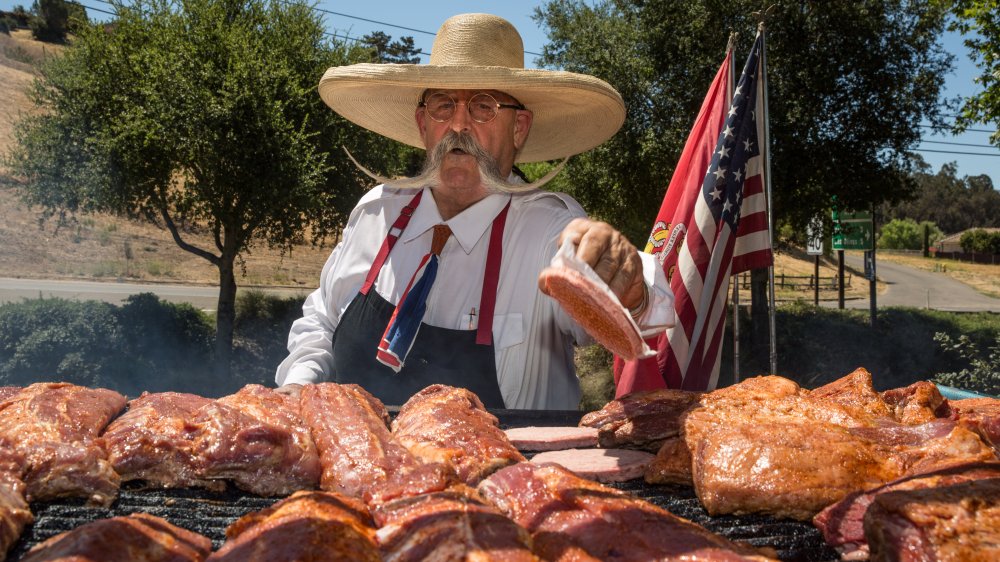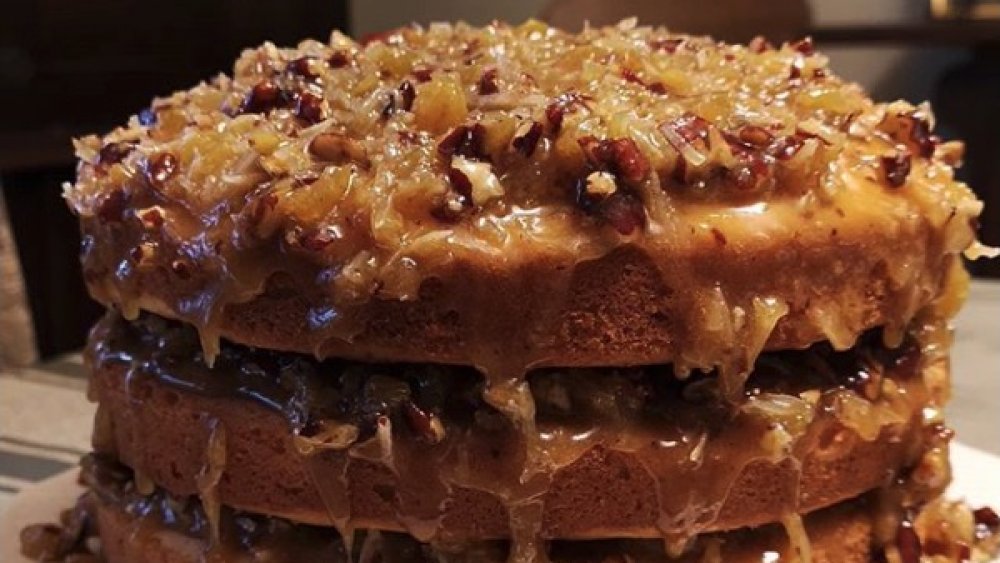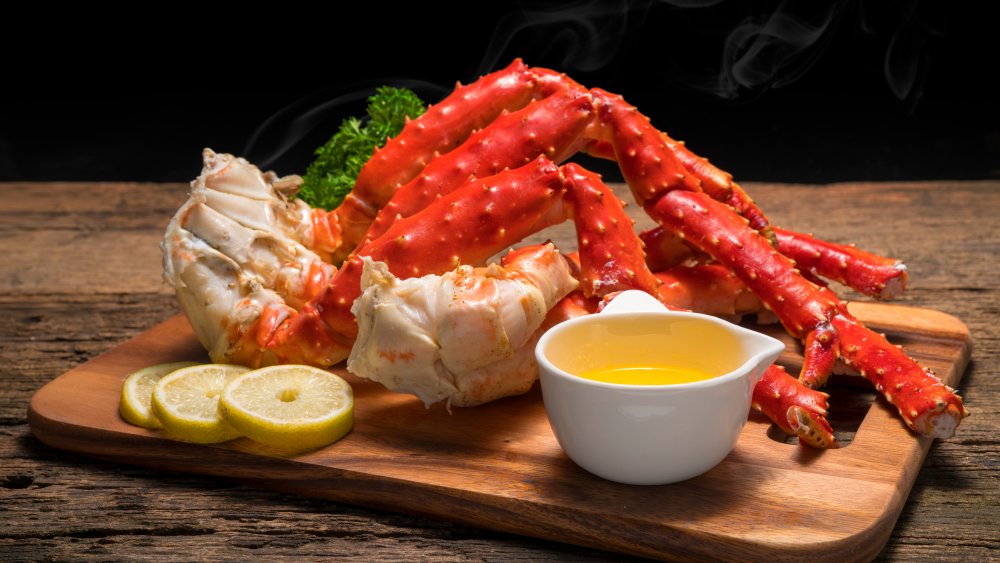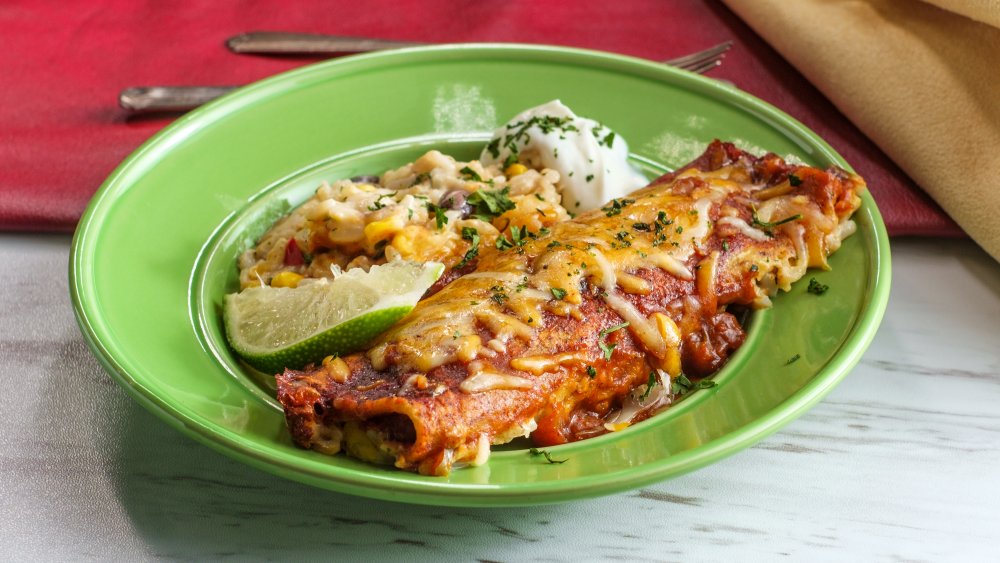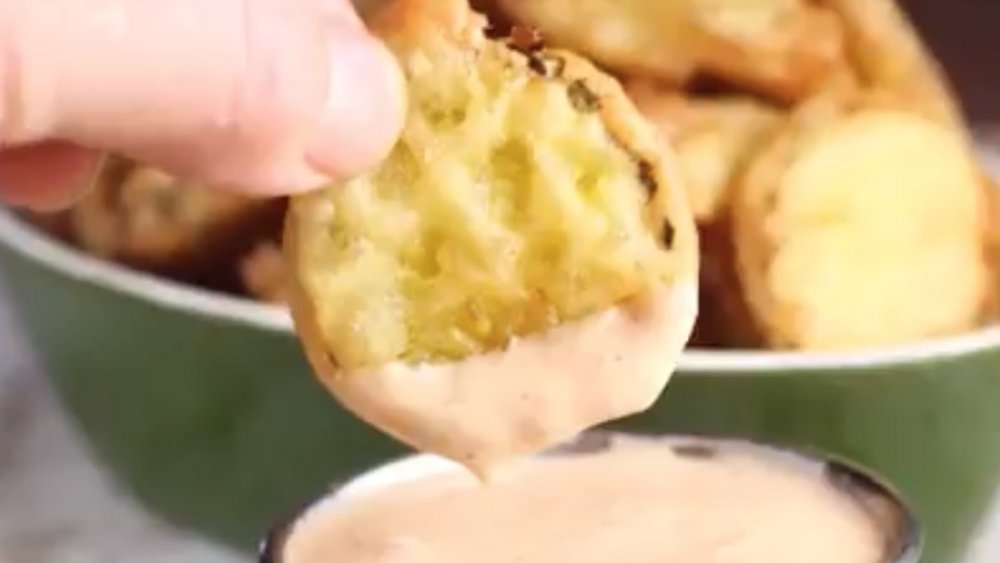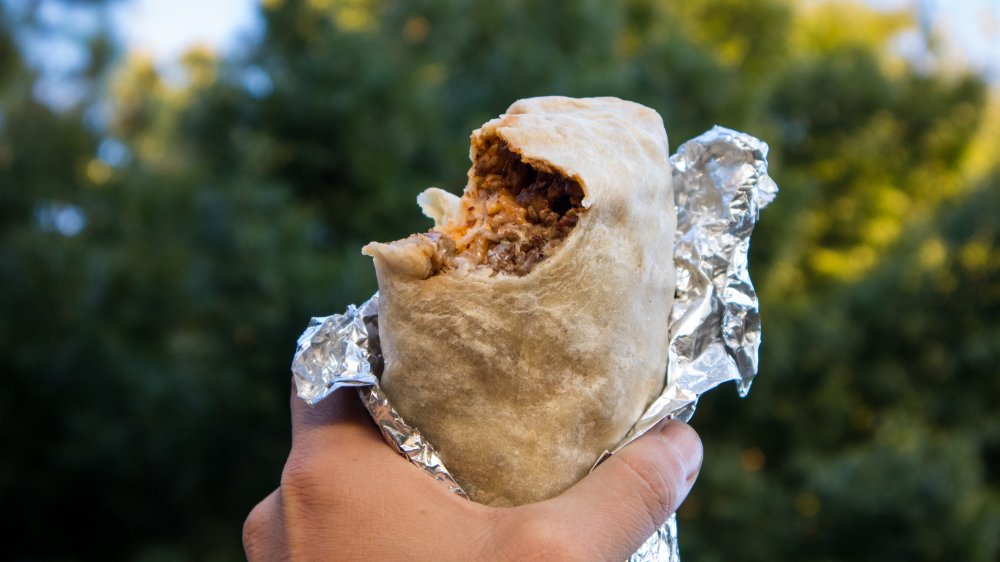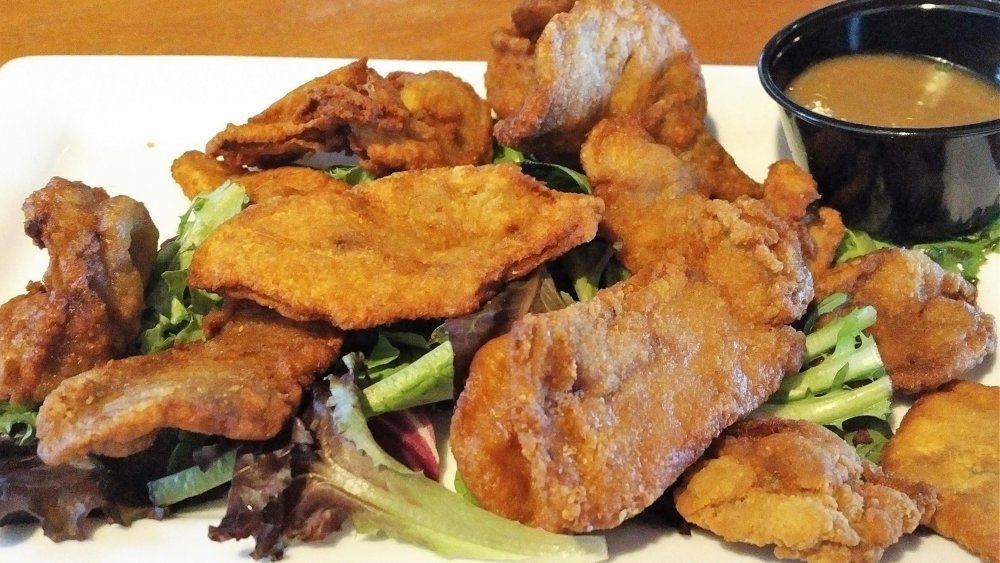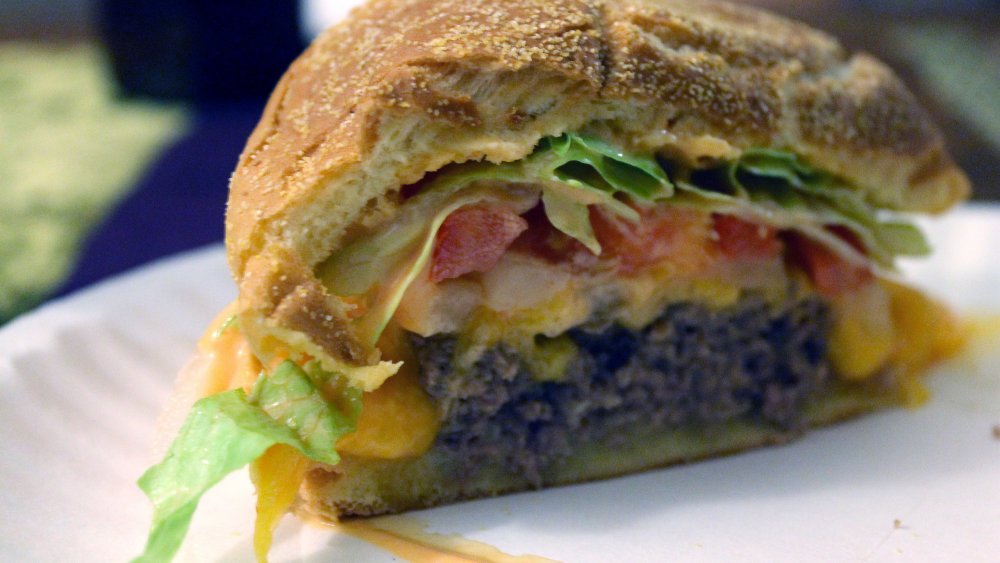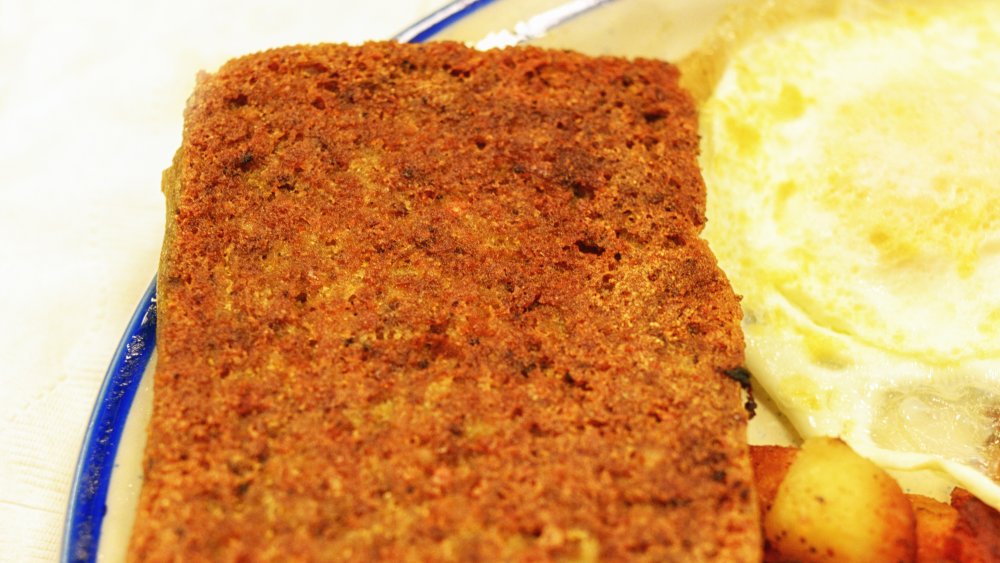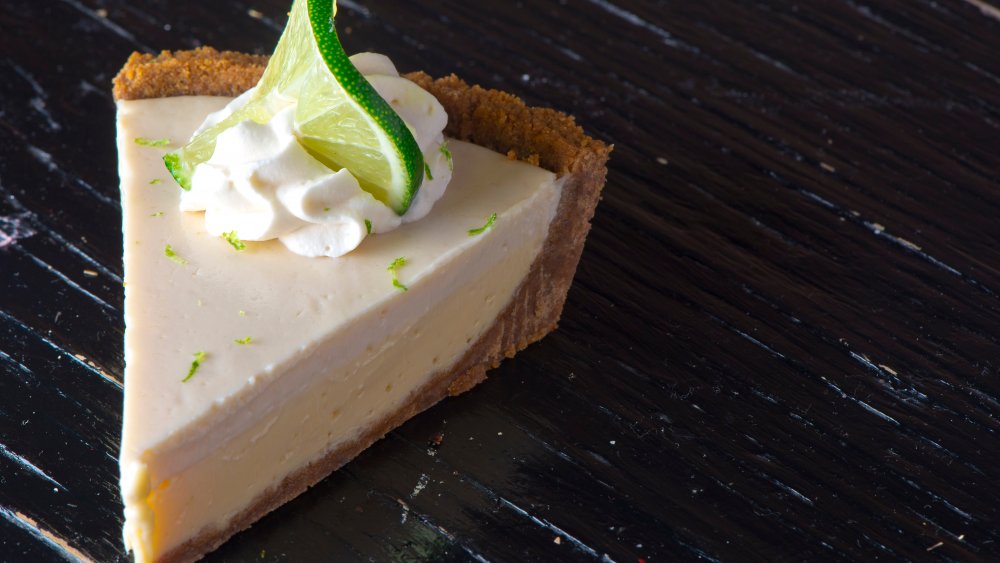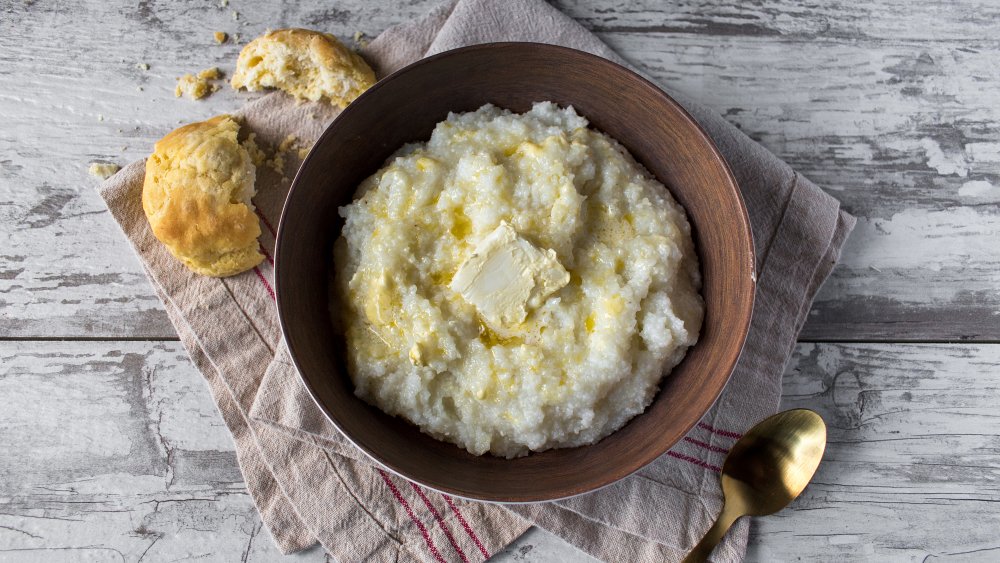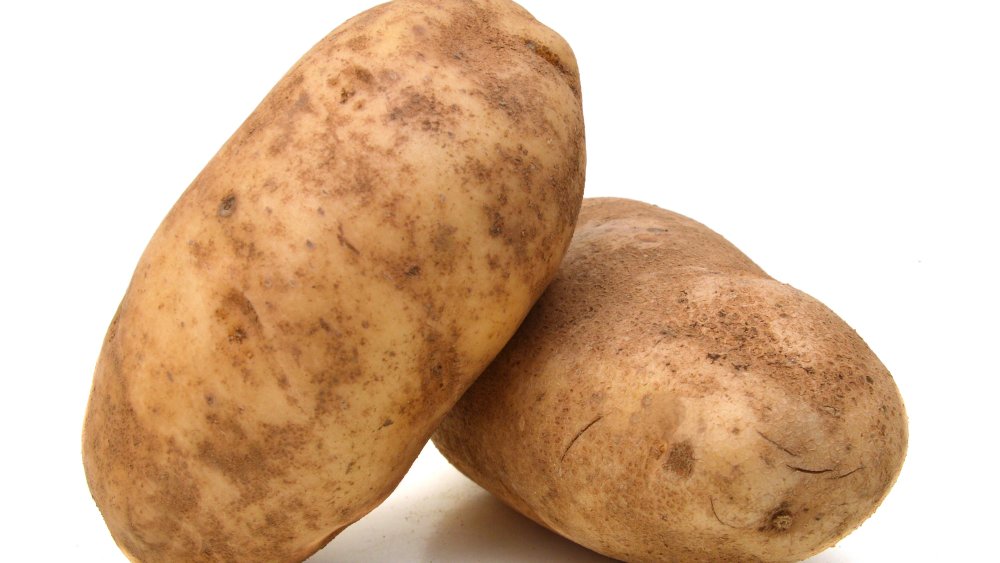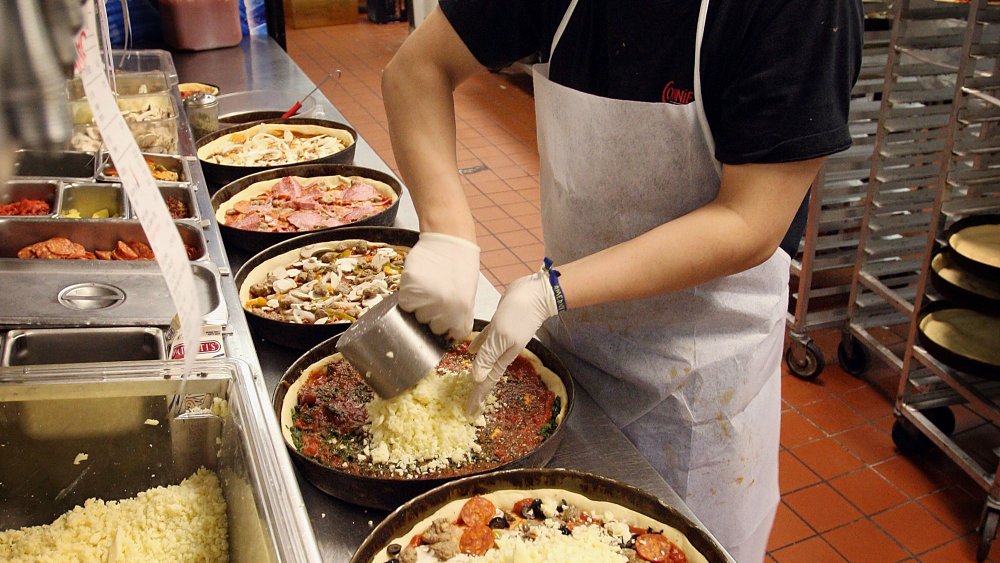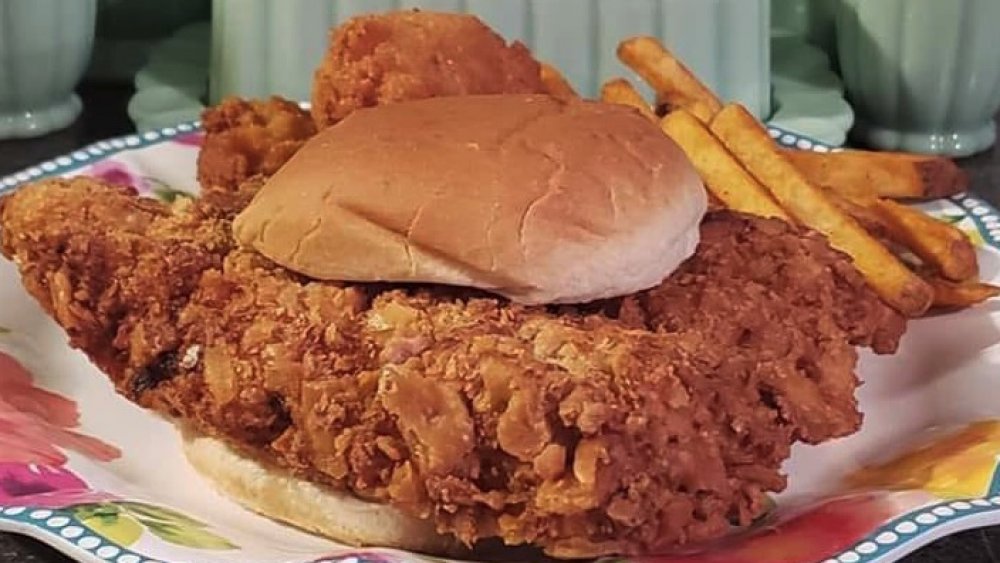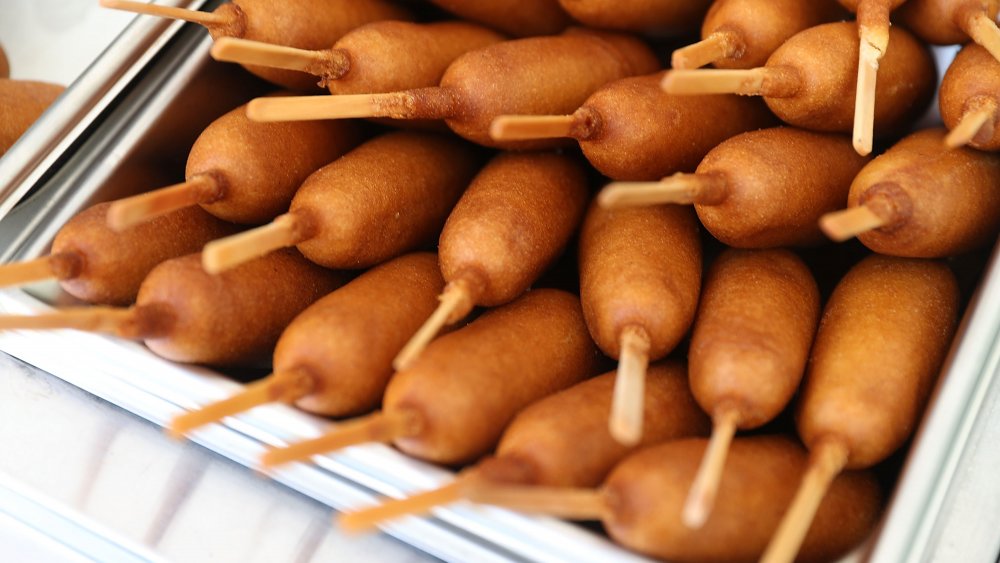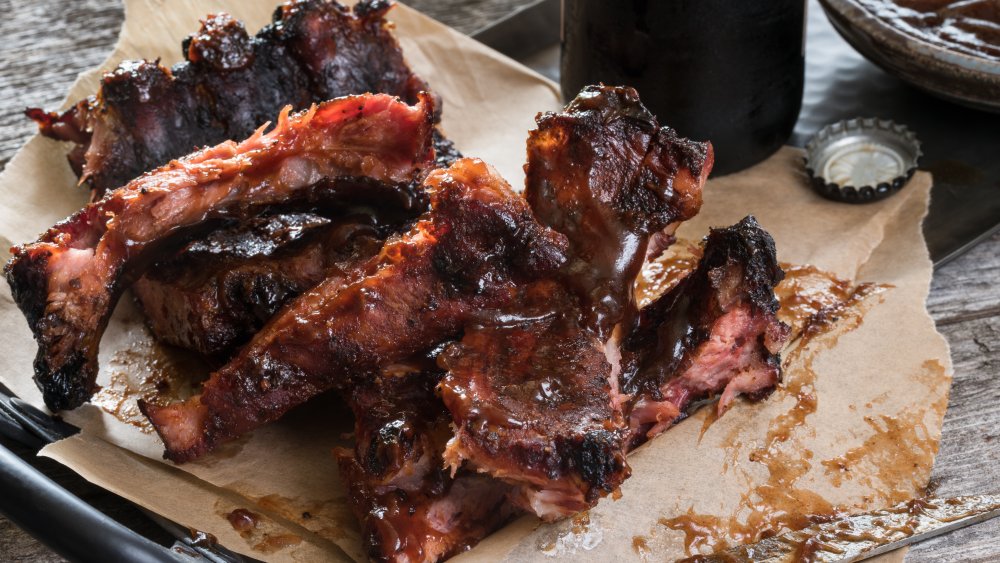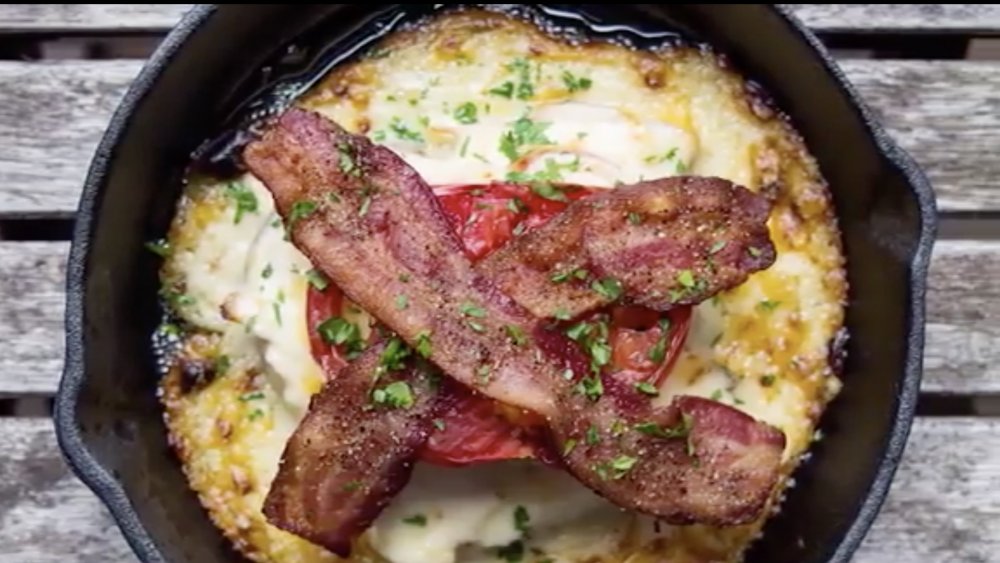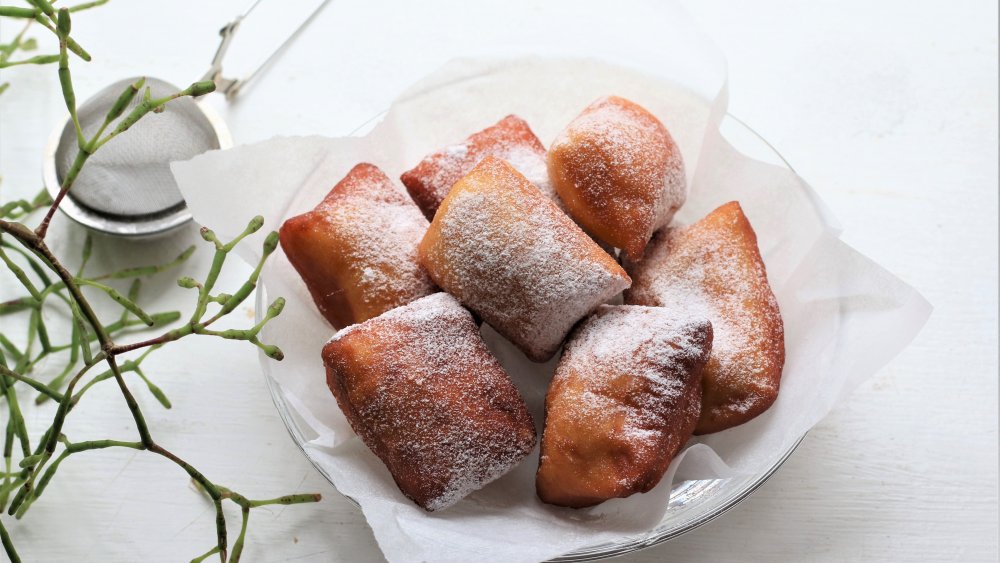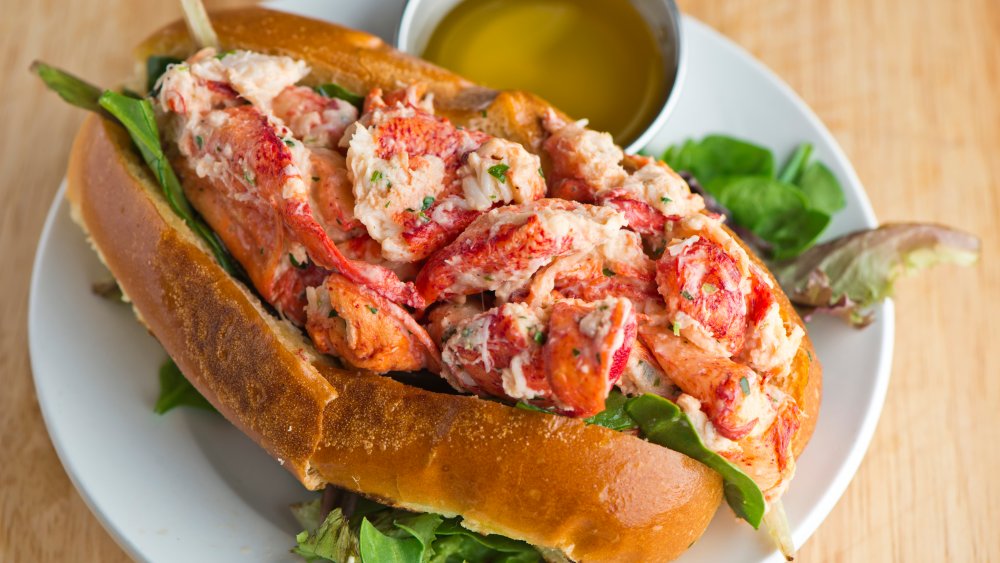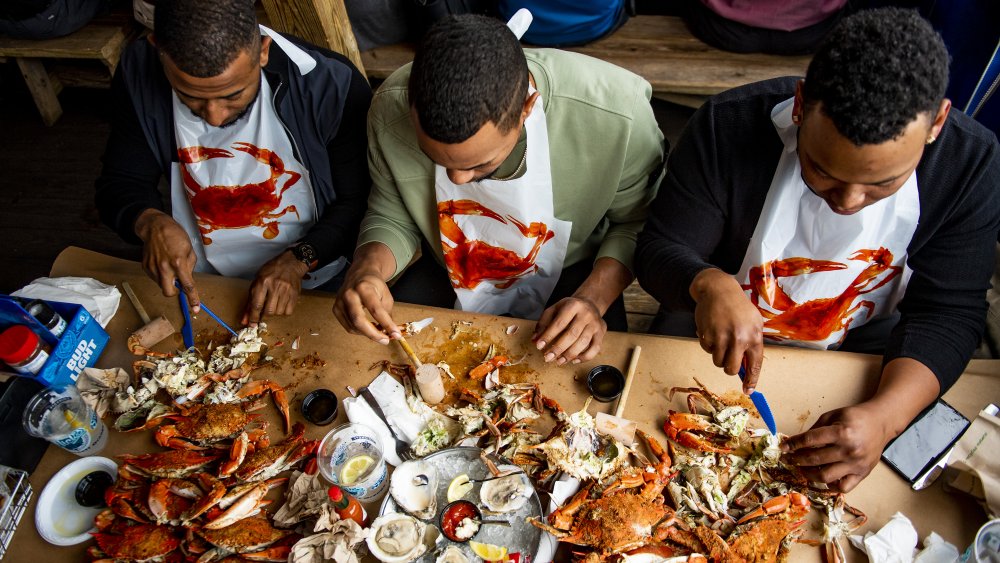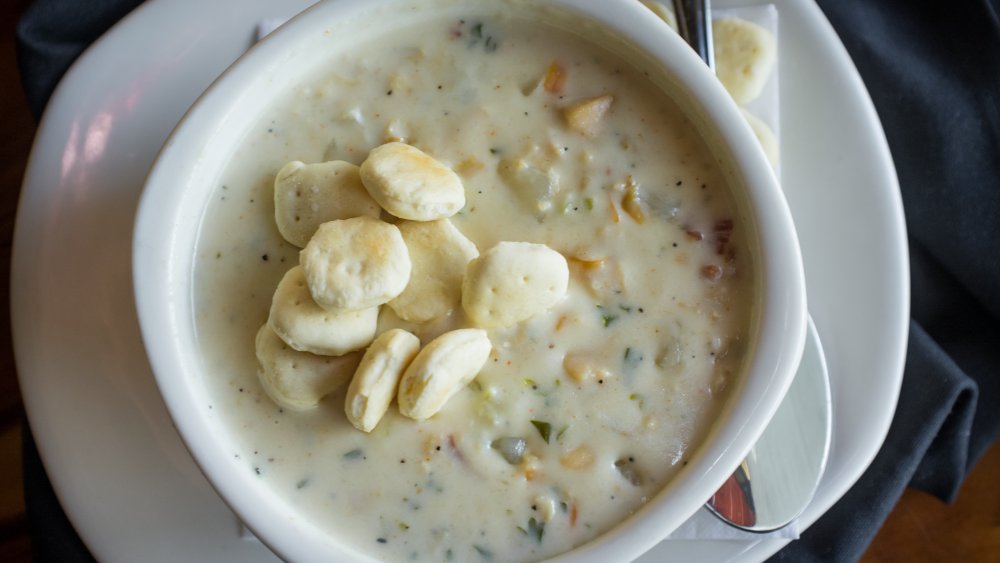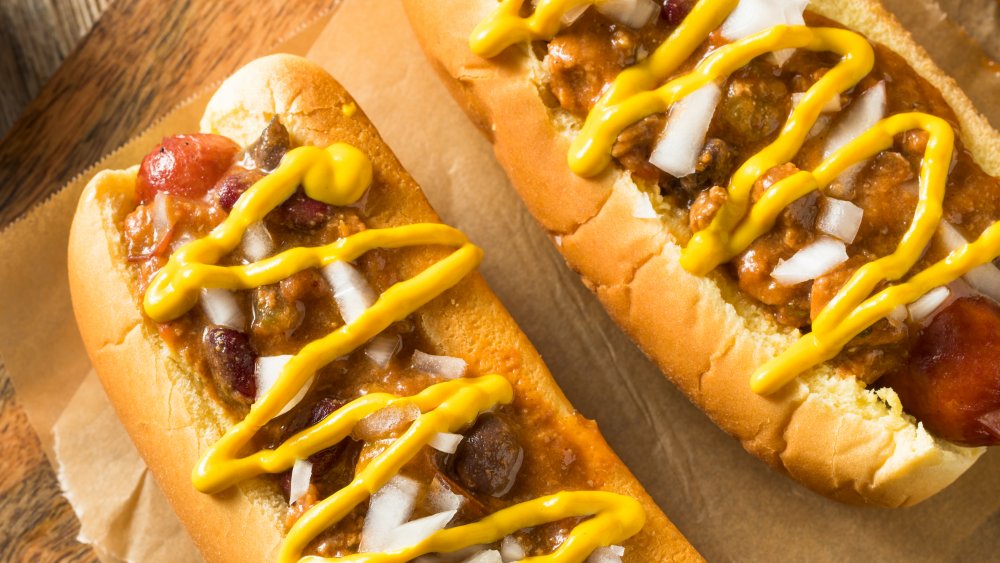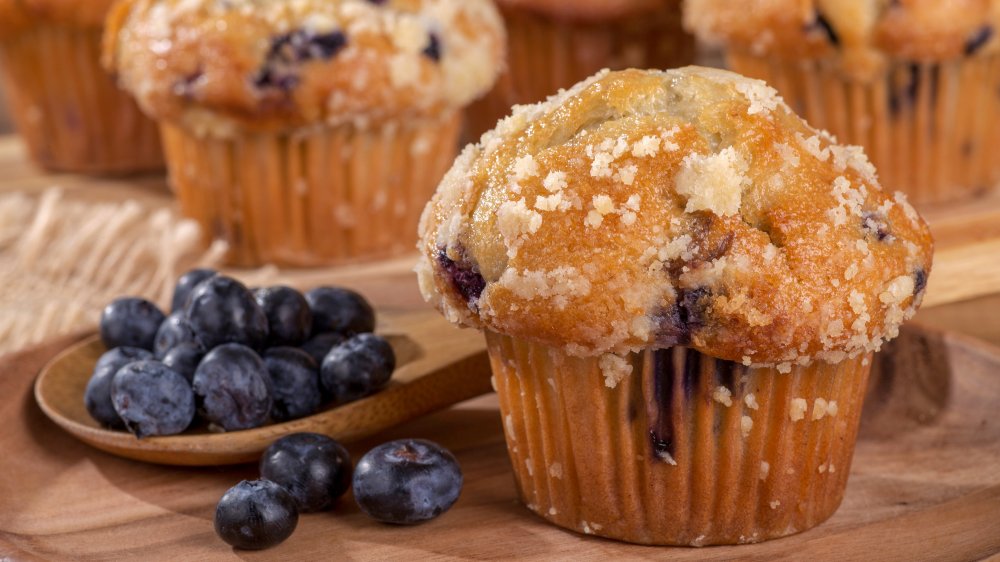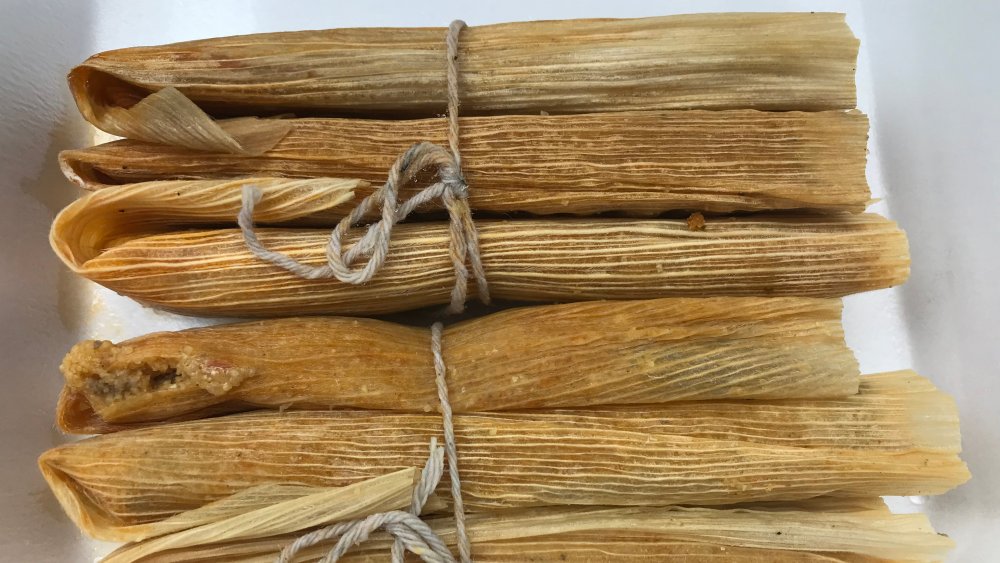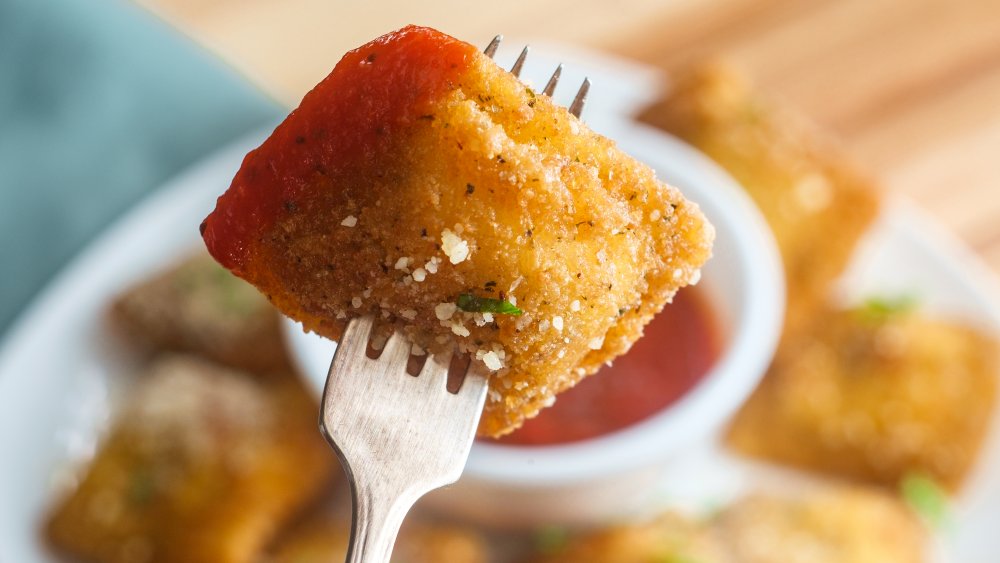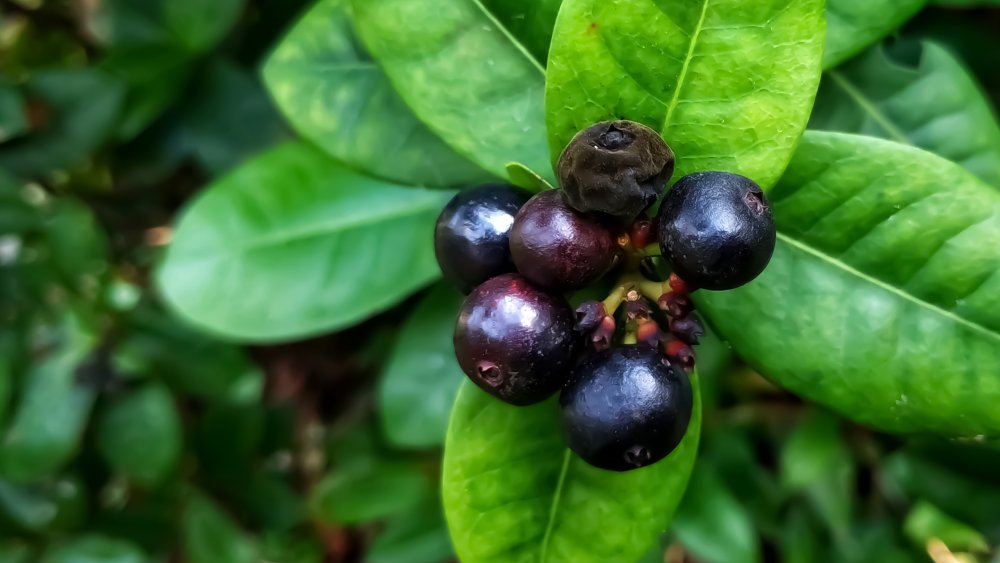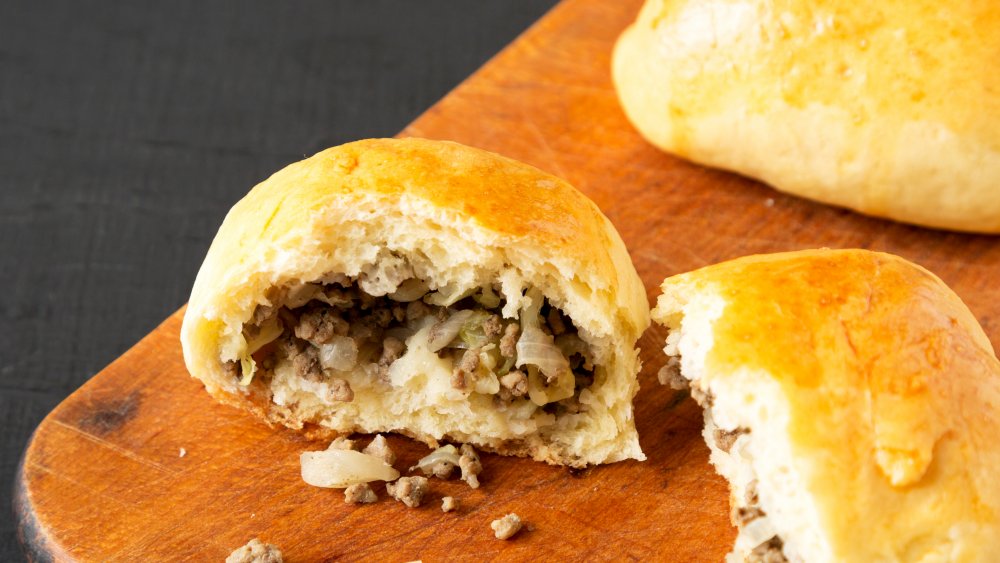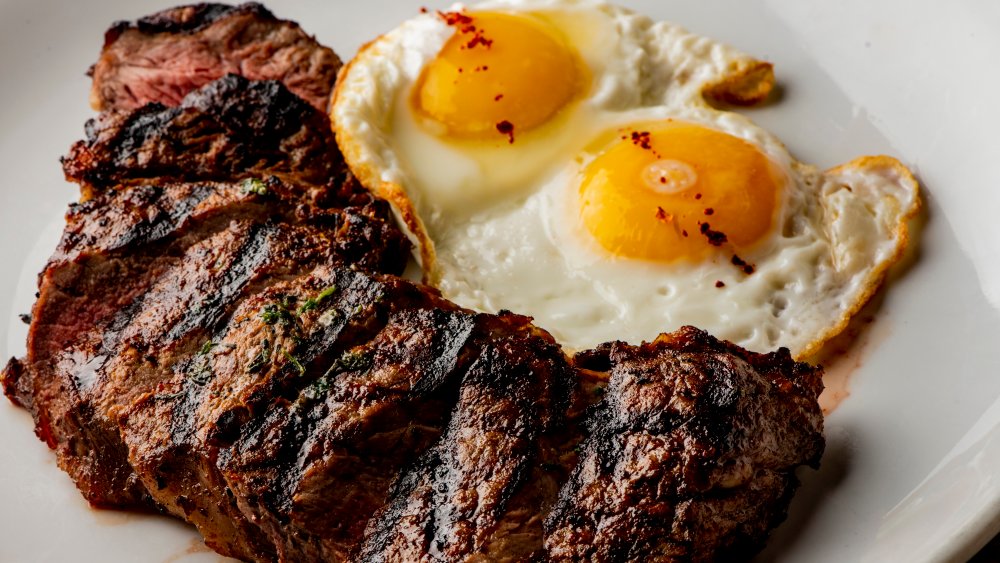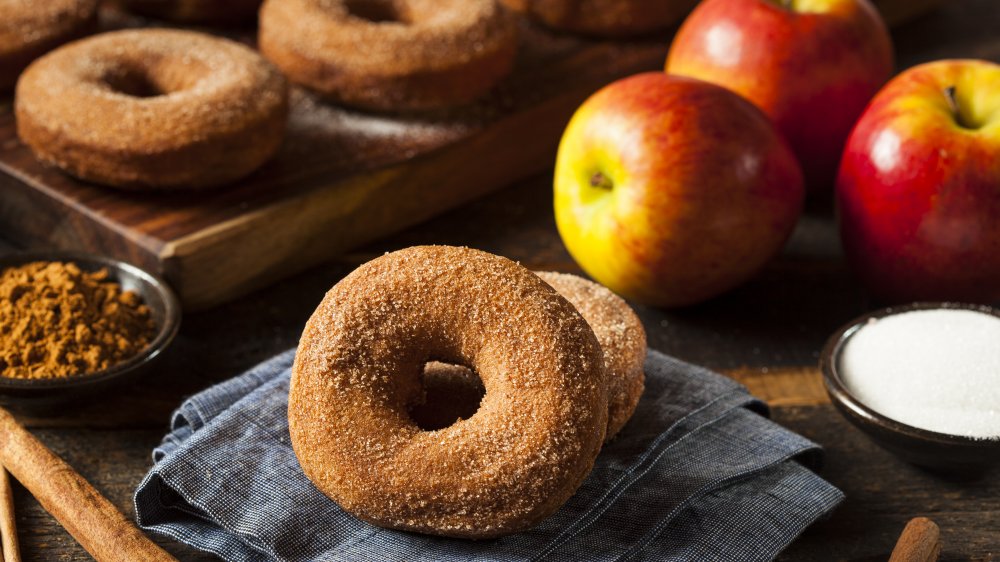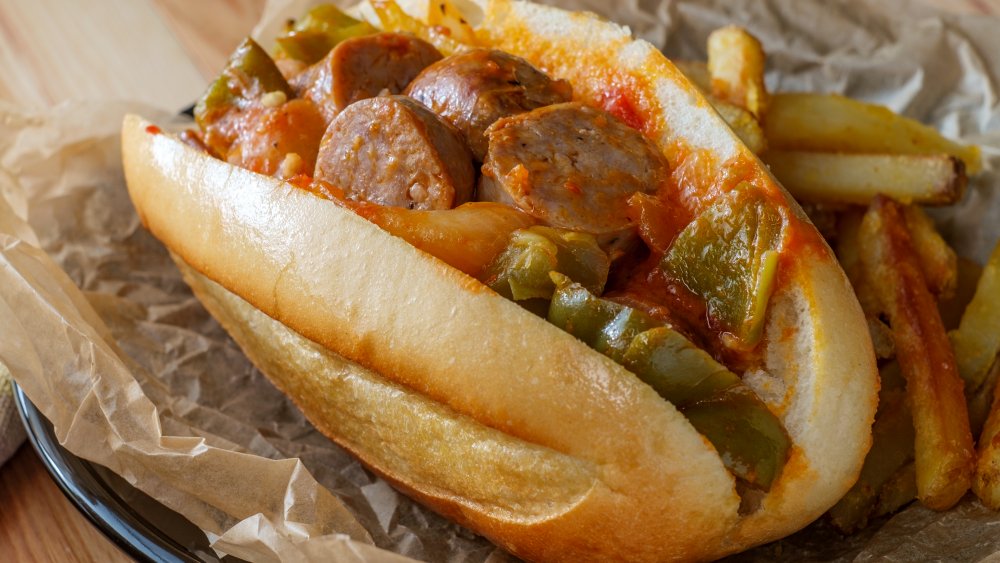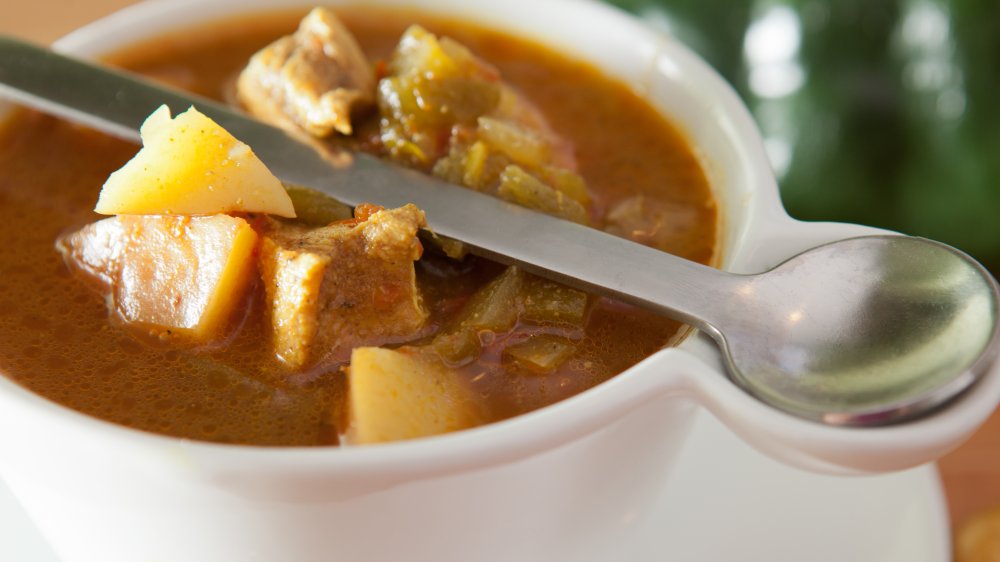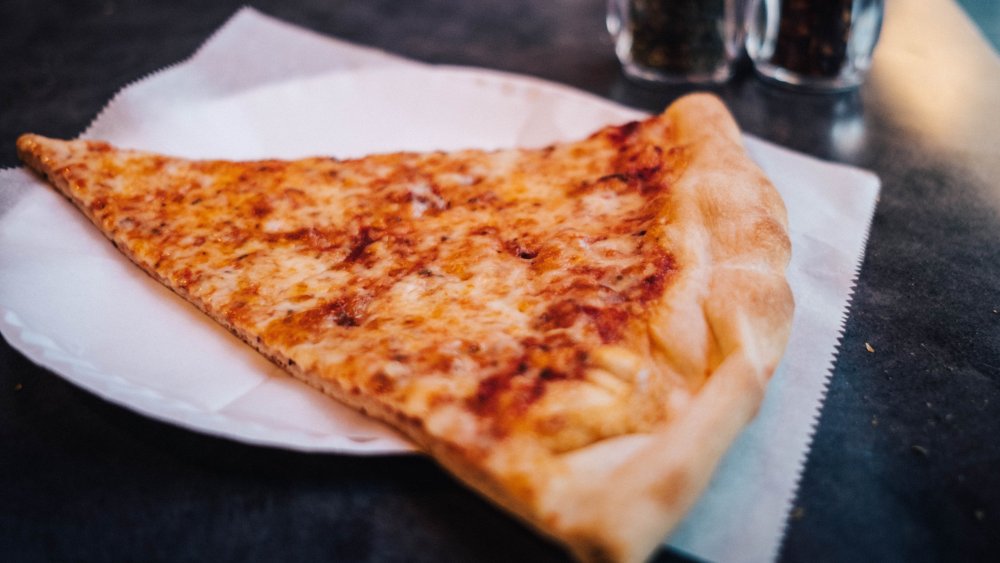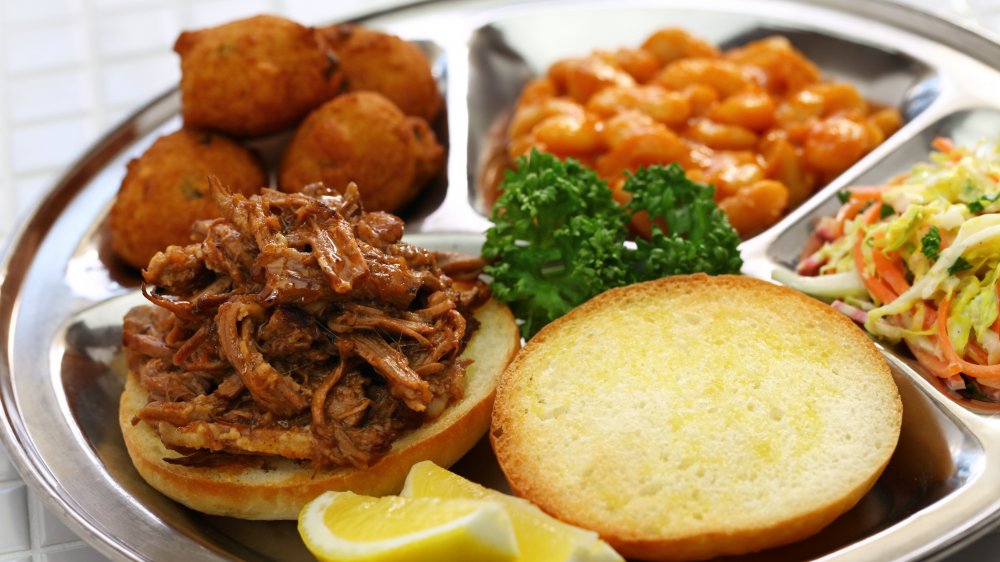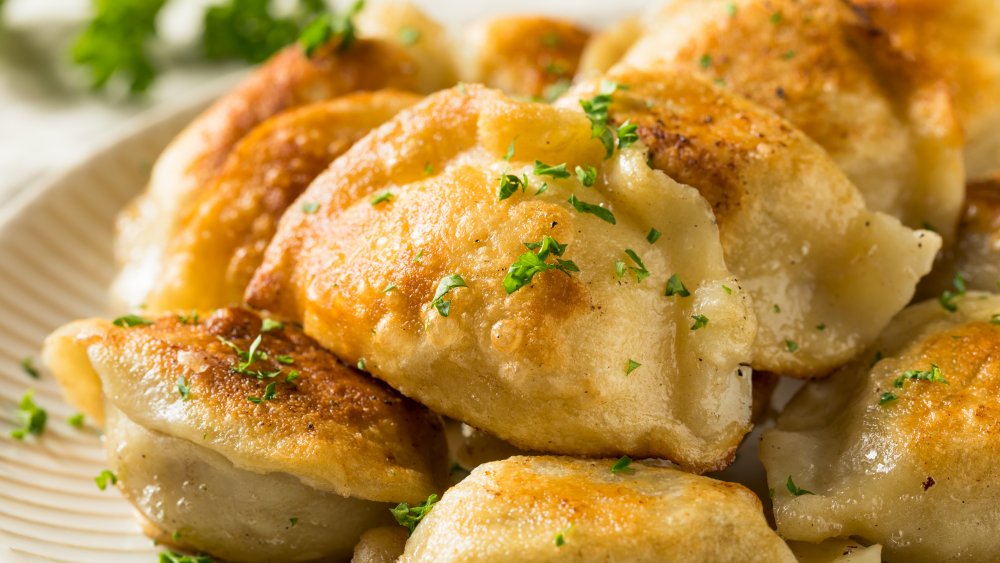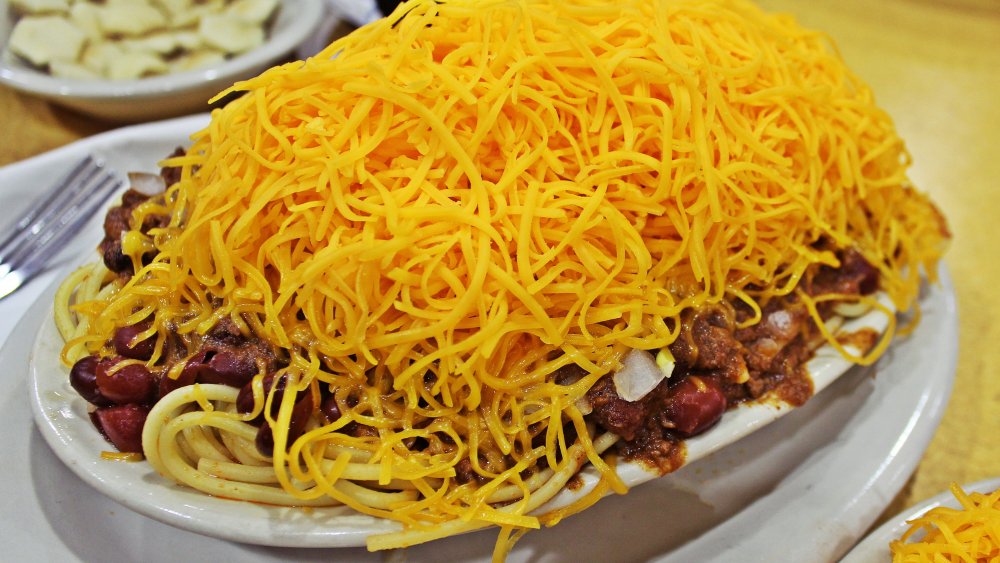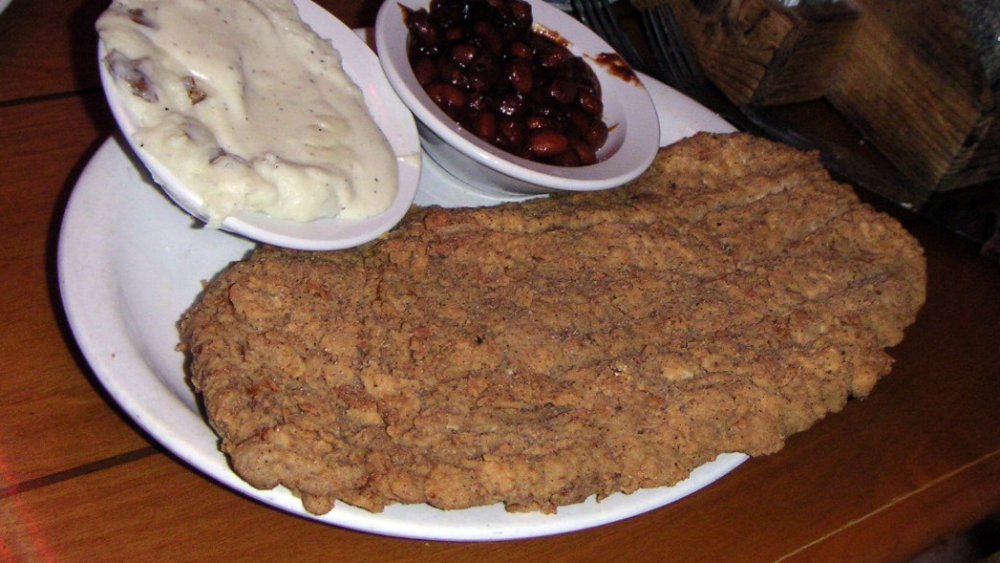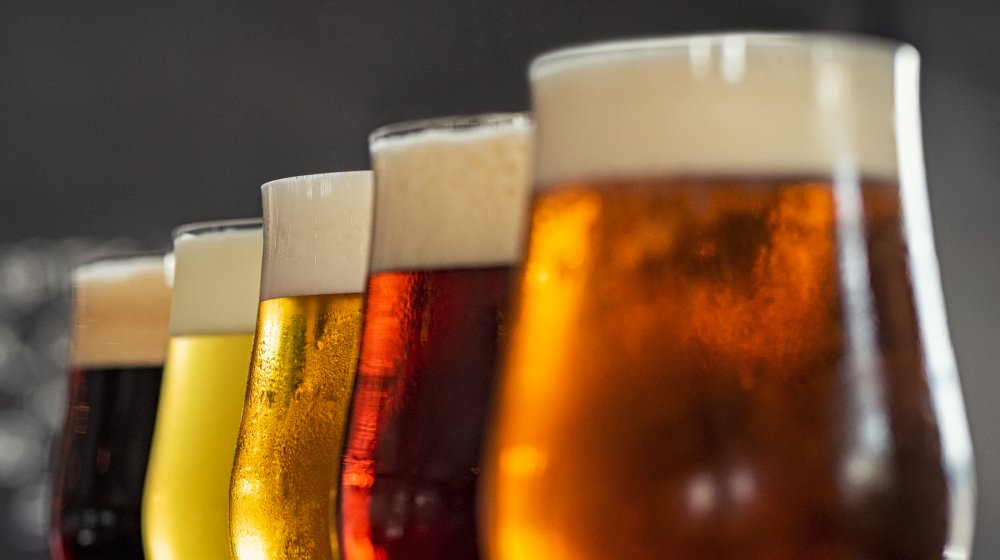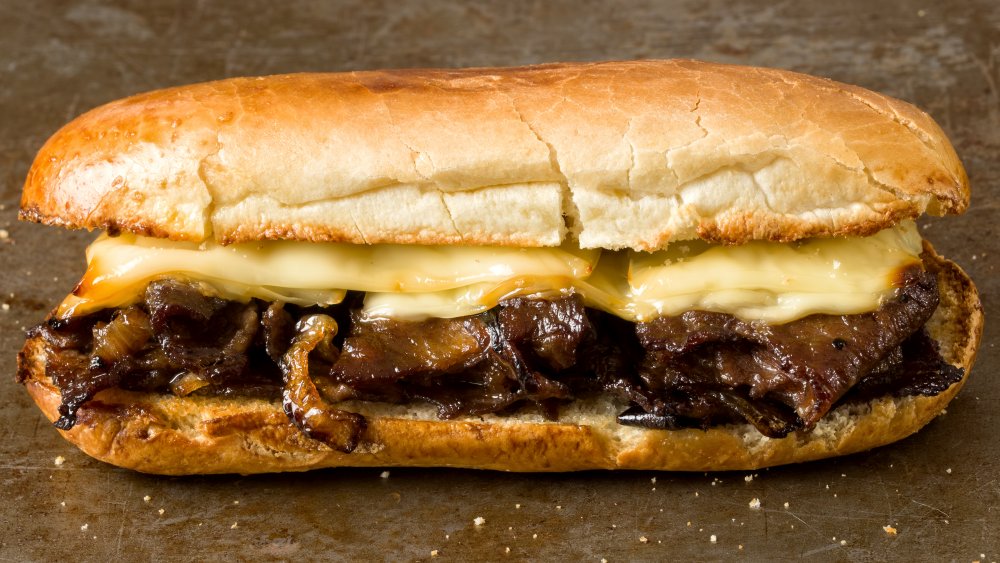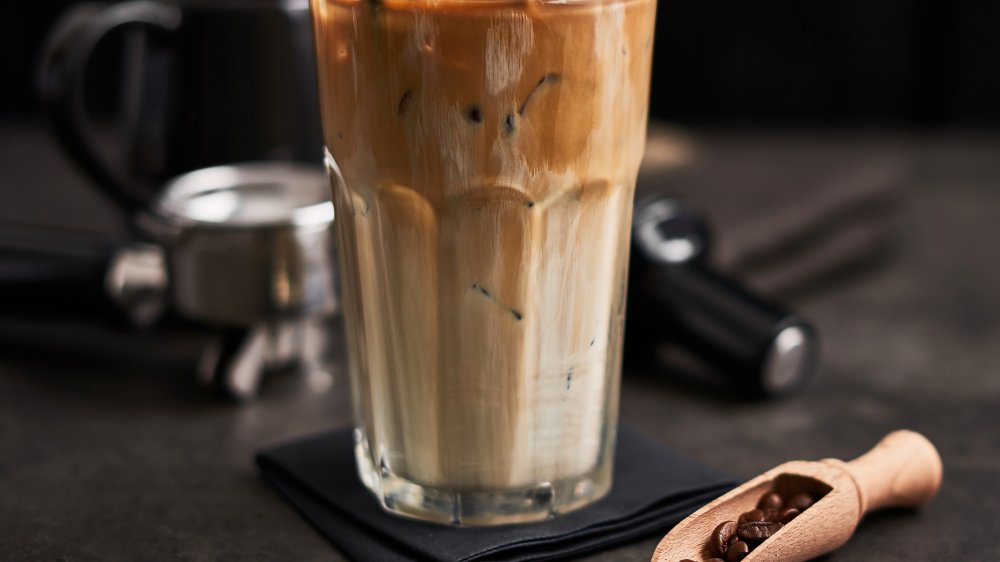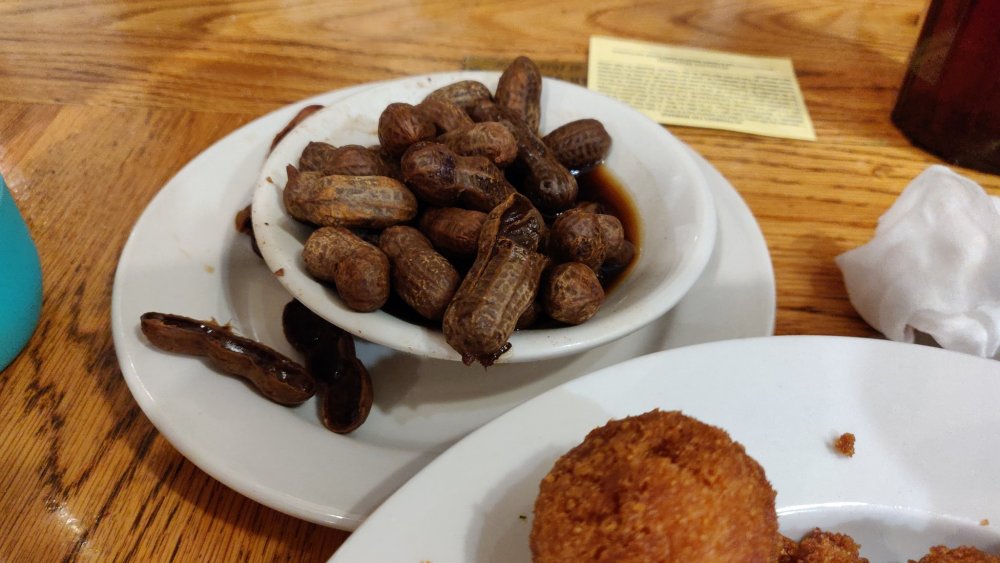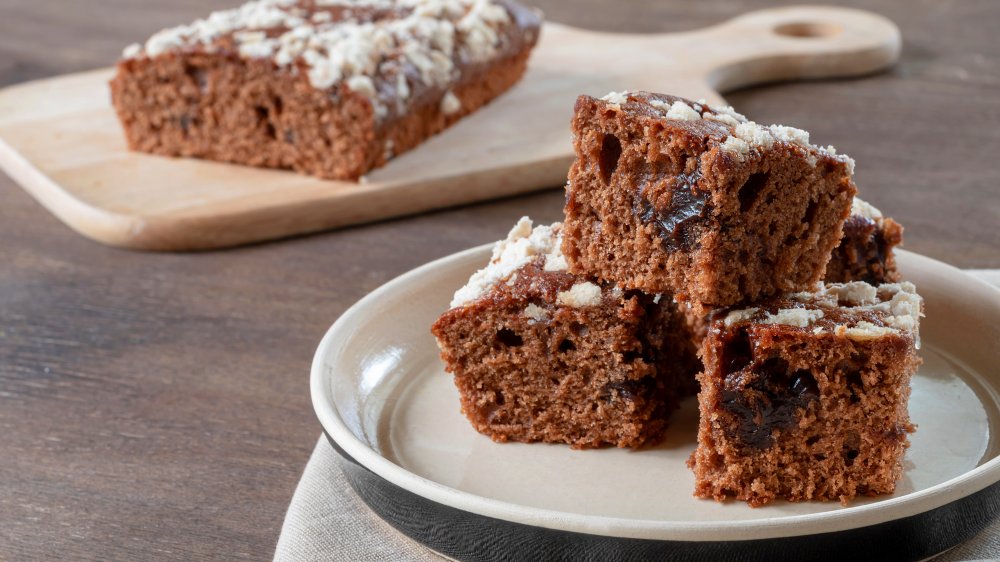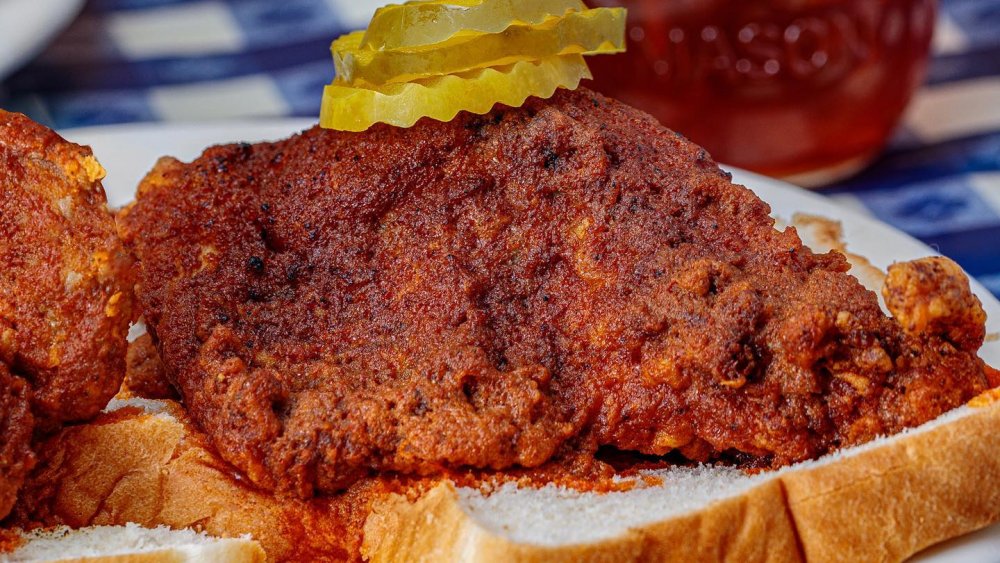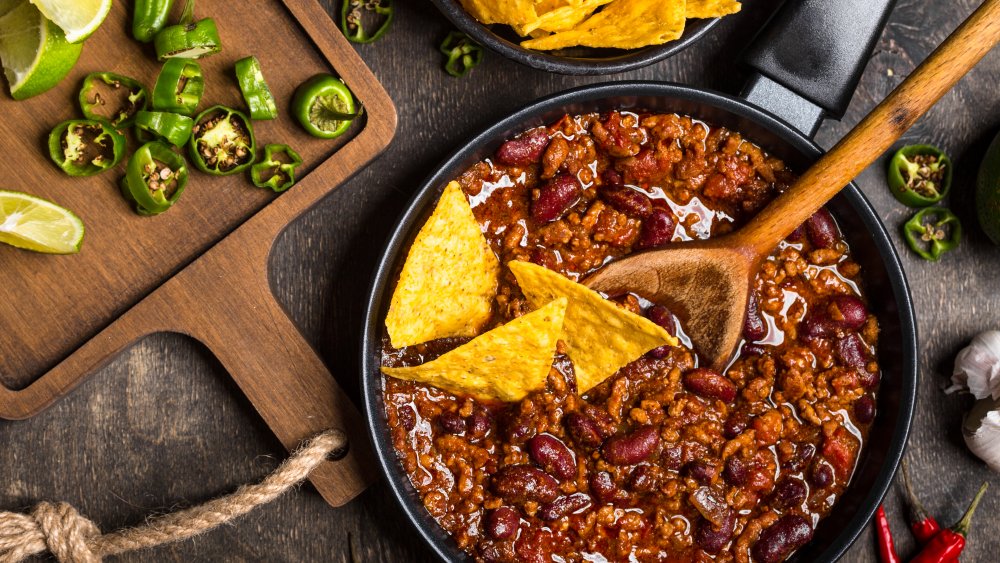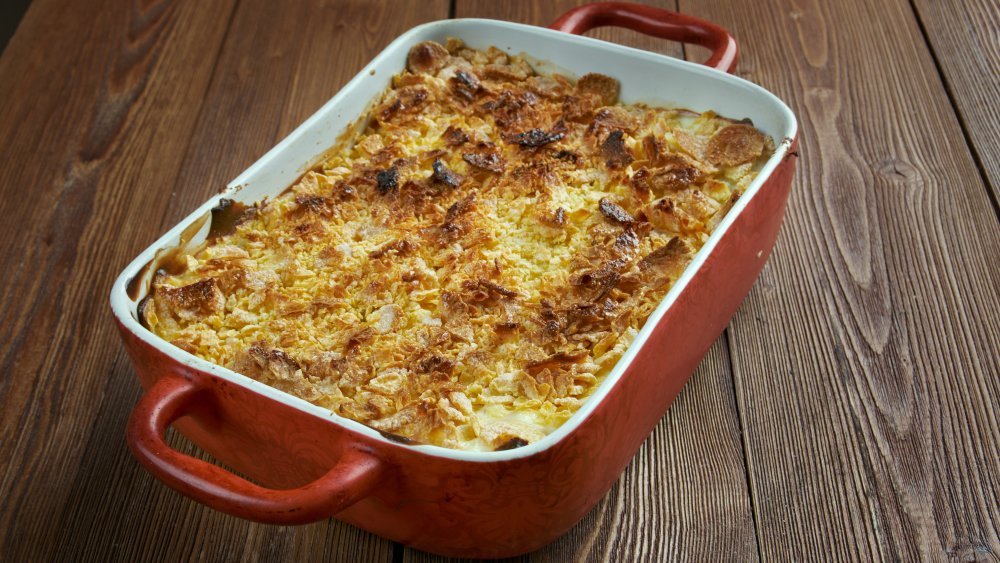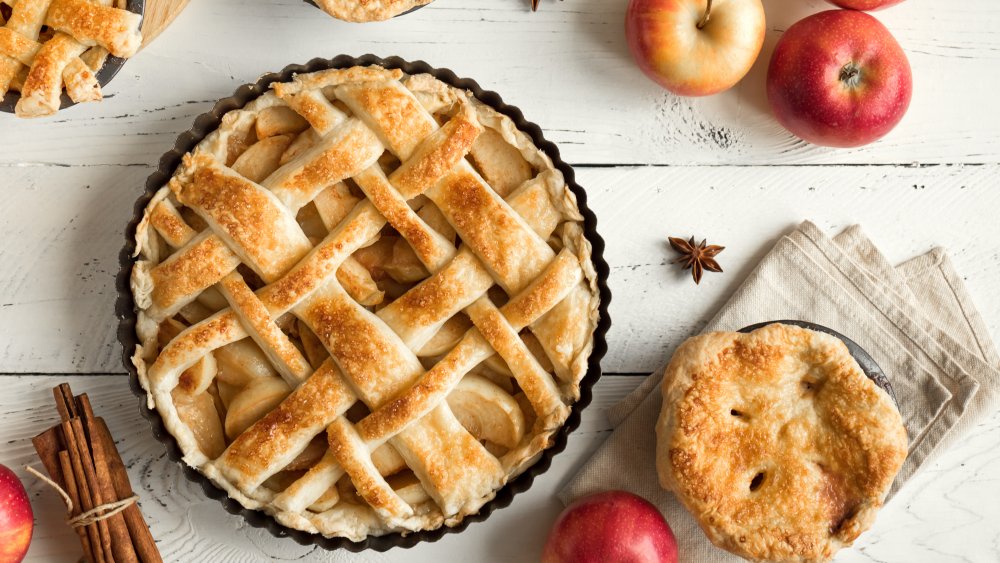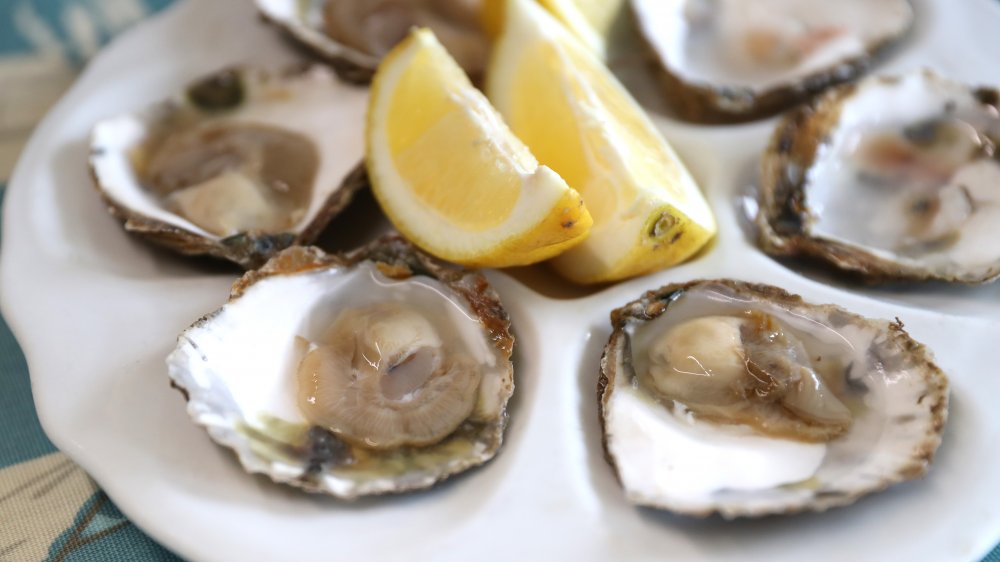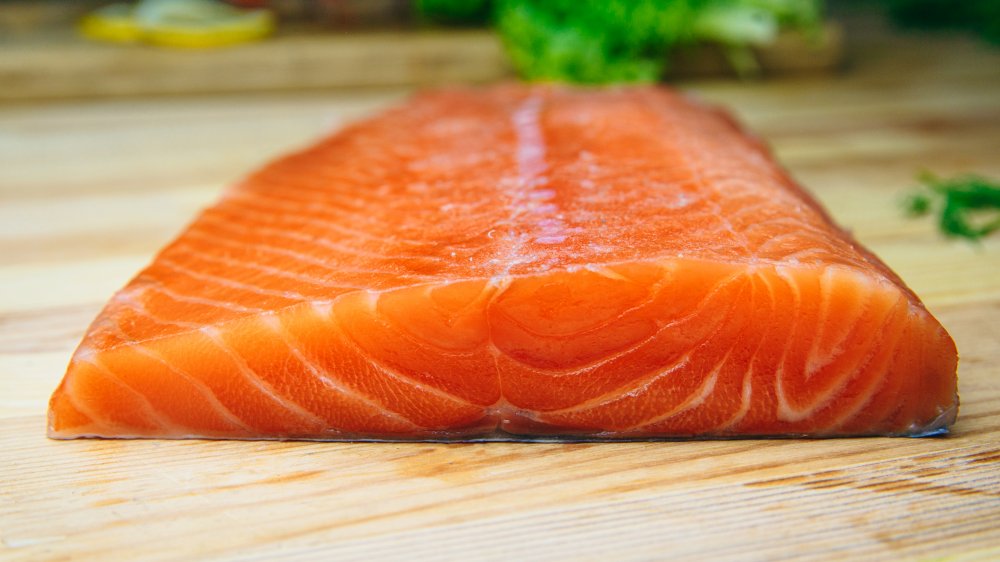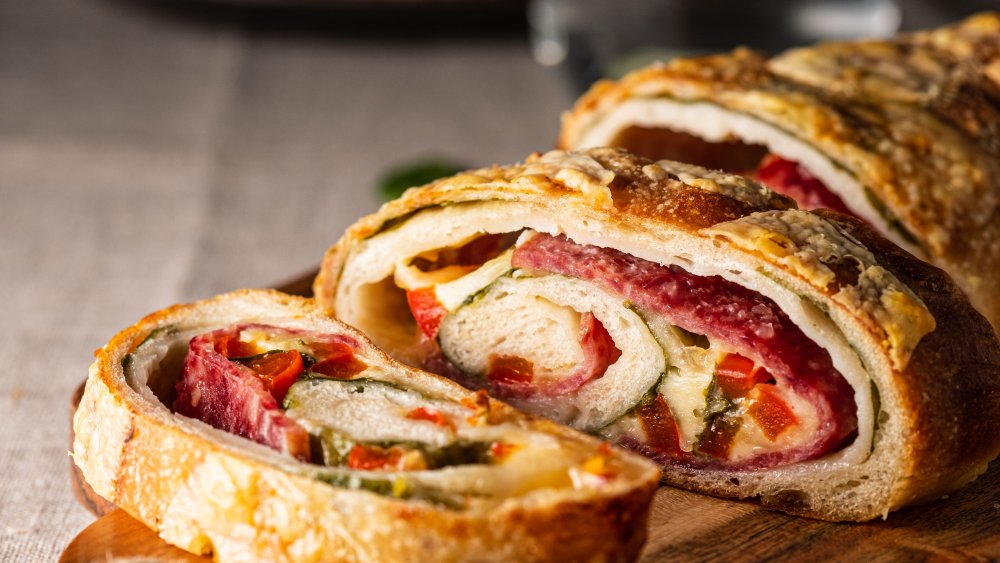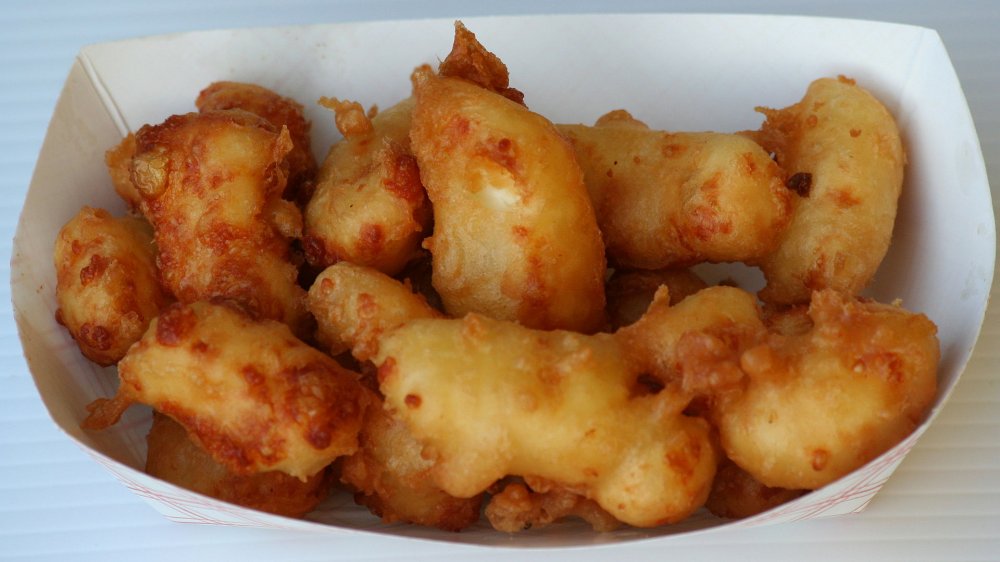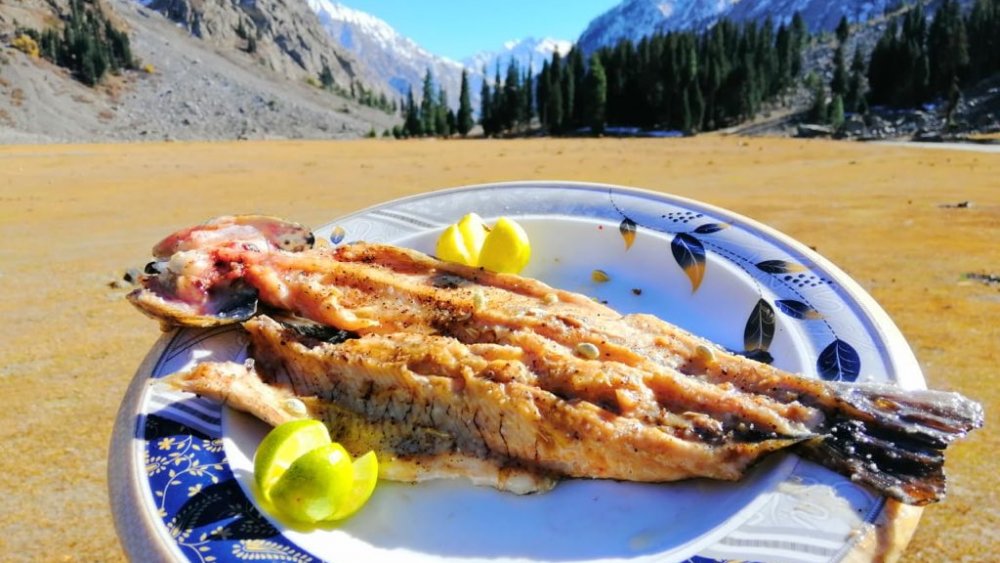These Are The Foods You Need To Try In Each State
"Oh, you're going to where? Well, you just have to try the..."
American cuisine is a rich, varied affair boasting delectable dishes inspired by our nation's cultural diversity, indulgent desserts crafted in time-honored tradition, unique meals making use of local flora and faunae, and a good share of deep fried stuff, of course. No matter where you go in the United States, you are sure to find a few foods you would be hard-pressed to locate in other areas and that you really should try before getting back on your way. Some states have official foods, like a state fruit or vegetable, while some even have official meals complete with prescribed sides and all.
Other states don't have official foods recognized by the government but do offer emblematic eats celebrated by the citizens. In some cases, the best foods to try in each state are based on location, as in with lobsters in Maine and cheese in Wisconsin. In other cases, it's a matter of cultural heritage, as with pizza in New York and the burrito in California. And sometimes there may be a state food you need to try just to check the proverbial box, not because your tastebuds are tantalized (Rocky Mountain Oysters, we're looking at you here).
Whether they become new favorite foods in your household or once in a lifetime bites taken as you pass through, here are 50 foods that you really should try for a true taste of America.
Alabama: Bourbon lane cake
The Lane Cake was created by Emma Rylander Lane (go figure), a resident of Clayton, Alabama, way back in the 1890s. Ironically, it was first served at a baking contest across the border in Columbus, Georgia. No matter the slightly outside debut of the Lane Cake, this sweet and often boozy dessert is a proud piece of Alabama heritage that's served at birthdays, weddings, holidays, and so on. It is mentioned in Harper Lee's classic novel To Kill a Mockingbird and is still a staple to this day.
The cake itself gets the majority of its flavor from a heaping dose of butter (one and a half sticks for a standard sized cake) and lots of vanilla extract, but it's the bourbon-rich mixture used between each layer and atop the Lane Cake that makes this a true must-try. That includes sugar, coconut, pecans, raisins, and of course bourbon, which is often added in quantities sufficient enough for an ABV warning. The next time you're in the heart of Dixie this state, make sure there's a slice of lane cake on your plate. And some coffee to wake you back up after dessert.
Alaska: King crab
There's a reason fishermen up in Alaska are willing to risk their lives on shows like Deadliest Catch – king crab tastes amazing. Also, it's a highly lucrative type of seafood to sell, which is of course the larger driving factor behind the trade. But for you, it's all about taste. Crab meat can be chopped up and mixed into crab cakes, it can be served in tacos or rolls, used in salads or soups, or it can be enjoyed on its own, ideally served slathered in butter and lemon. And while you can get king crab meat from Alaska in fine dining establishments all over the globe, it's hard to beat eating a freshly caught and cooked crab.
You will also pay a lot less for crab meat in Alaska, which is a good thing, as you may pay as much as $50 or more for a pound of Alaskan King Crab meat when you buy it farther afield. And if you're planning to pay market price at a steakhouse you might as well save your money by booking a flight to Alaska, more or less.
(Also, don't spend too much time Googling images of an Alaskan King Crab (also called the Red King Crab or Kamchatka Crab) because they're pretty terrifying to look at, what with a leg span potential of nearly six feet.)
Arizona: Chimichanga
The world brilliance comes to mind when one thinks of the chimichanga, a signature Mexican-American food beloved all over the nation that traces its roots to Arizona. Brilliance, because that's what it took for someone to look at a burrito, a finished foodstuff ready to be served and eaten, and say: "Wait... fry it. Fry the whole burrito." That's what a chimichanga is, it's a fried burrito usually served topped with cheese and salsa and sour cream, and though far from a healthy food, it is an absolute delight to eat.
Almost surely not an authentic Mexican food, the chimichanga was apparently first "created" in Arizona sometime in the 1950s. There is a potential apocryphal story that a chef at a Mexican restaurant in Tucson accidentally dropped a finished burrito into a deep fryer and decided to try the thing after retrieving it. Another story says a Phoenix chef intently created the new fried burrito after experimenting with myriad other ways to put new spins on established foods. Or maybe the first chimichanga was created just south of the border in Mexico, then made its way into Arizonan fare. We'll probably never know for sure, but to be sure this delightful food spread from Arizona to menus all across the land, and if enjoyed in moderation, this taste of the Copper State is not to be missed.
Arkansas: Fried pickles
Fried pickles are on menus far and wide today — you can't walk into a Buffalo Wild Wings or roadhouse or burger joint without seeing the things offered with a side of sauce and a stack off napkins. But despite their ubiquity today, fried pickles can be traced right to Pope County, Arkansas in the summer of 1963. That's when restaurateur Bernell "Fatman" Austin put fried pickles on the menu and created one of the world's most beloved appetizers (and burger toppers). It makes sense that Austin came up with a way to enhance and thus upwell pickles: his drive-in restaurant was across the road from the Atkins Pickle Plant, the main pickle producer in the state of Arkansas, so he had a ready supply of the foodstuff.
First created as something of a gimmick ("fried what? Now this I gotta try!" e.g.) fried pickles became so popular that soon people were traveling long distances to try Austin's fried pickles at his Duchess Drive In and not long after competitors started selling their own fried pickles as well. The new food spread across the South and soon across the nation. Today it's hard to imagine a certain set of restaurants without fried pickles on the menu.
California: Mission burrito
California's Mission Burrito is beloved by millions today but has in fact, only been well-known outside Latino culture for a generation. You likely take this type of food for granted now, the Mission-style burrito being what you get at a Chipotle, at many a Mexican or Tex-Mex restaurant, and what you may even roll up for dinners at home. But before the 1990s, these large, dense burritos, a staple in many Mexican-American households and restaurants, were basically unknown to the mainstream American diner.
The rapid expansion of Chipotle explains much of why Mission Burritos are now common. If these burritos are now available all over, why should you venture to California to try one? Arguably, you should do so precisely because they're now pedestrian. In the Mission District of San Francisco, you will find dozens of restaurants selling Mission Burritos, each of which tries to stand out in its own way in order to gain a share of the saturated market. From secret spice blends to massive heaping portions of carnitas to wonderfully fresh ingredients, the best Mission Burritos are found in California, the place both of their origin and of their mastery.
Colorado: Rocky mountain oysters
Colorado Rocky Mountain Oysters may not be for the faint of heart, but they are tender and delicious. Their name is one of the greatest euphemisms — or shall we say outright deceptions — of the culinary world. They are usually bull or bison testicles, though occasionally made from the testes of sheep or goats, and sometimes pigs, and are prepared by skinning, breading and spicing, and then deep-frying. Often these Mountain Oysters, as they are also called, are pounded flat before cooking, which further belies their origin and which may make enjoyment thereof easier for squeamish diners.
If you can get over the ick factor here, you will enjoy genuinely tasty and delicate food with an unusual flavor profile often described as more akin to venison or even calamari, in the opinion of many aficionados. First eaten by Rocky Mountain ranchers who didn't want to waste any edible foods and often had a surplus of, well, bull balls after castrating numerous head of cattle, the "oysters" grew from a food of convenience for working men to a menu staple in many restaurants largely because they are quite a fine appetizer, and partially for the novelty factor that sees patrons daring one another to gobble down a few.
Connecticut: Steamed cheeseburger
The steamed cheeseburger is a juicy Connecticut original you may love or loathe, depending both on your taste buds and on your openness to new takes on staple foods. As the name suggests, this is a burger that is cooked in a closed vessel using steam heat, not grilled or prepared on a griddle or in a pan. The result is a burger patty that's moist, tender, and flavorful, but it is decidedly absent of the charred taste of a standard burger. This is precisely why some people will simply not like this type of burger: it will seem to be missing something you may feel integral. On the other hand, treat it like its own unique eat, and you may find yourself heading to Ted's Restaurant in Meriden, Connecticut on the double. Or to one of the other many burger joints in Connecticut that proudly offer this CT OG, from East Hampton to North Haven to Cromwell and beyond.
And don't bother looking too hard for a good steamed cheeseburger outside of Connecticut, they're hard to find outside the Constitution State despite being a nearly hundred-year-old innovation. Steamed burgers were first sold at a Middletown restaurant called Jack's Lunch as far back as the 1920s.
Delaware: Scrapple
Don't ask what's in Delaware's semi-official state dish, scrapple – just eat and enjoy. But since it seems like you're probably asking, scrapple is made from ... a lot of animal parts, basically. It often features liver, kidneys, hearts, offal (which just goes to show you how obscure the stuff in scrapple is, offal itself being a "polite" term for entrails and organs), and other meat stuff. That meat stuff is then mixed with cornmeal and spices and cooked in a broth before being formed into loaves. Once cooled and set, these are served as scrapple.
Scrapple is rather like a blend between meatloaf and sausage, and it's a staple dating back to colonial times when no edible bits of anything went to waste.
Florida: Key lime pie
Key Lime Pie is big business in Florida. The dessert is native to the Sunshine State, it became the Official State Pie in 2006, and it even enjoys its own Florida food festival every year. While native to Asia, the key lime thrives so well in Florida that it even takes its name from the Florida Keys, the islands lying near to the coast of much of the long peninsular state. Key Lime Pie may be available just about anywhere pies are sold, but you can't beat one made fresh using fruits picked from the trees mere days or even hours before the dessert is prepared.
Georgia: Grits
Simple but wonderful, grits became Georgia's Official State Prepared Food almost 20 years ago, and why not? They may be humble, but they're a proud food. And dressed up, grits can be a surprisingly complex and fancy dish, too. As stated on the Georgia Secretary of State webpage: "Grits are bits of ground corn or hominy which constitute a uniquely indigenous Southern food first produced by Native Americans many centuries ago. Corn is a preeminent Georgia crop grown throughout the state. Grits can be a pure and simple breakfast dish or can be incorporated into gourmet cooking through countless recipes." And in case you're wondering, hominy is corn, it's just been soaked in an alkali solution that softens and engages the kernels through a process called nixtamalization. The more you know!
Hawaii: Shave ice
Hawaii has a lot of pretty amazing foods to try, from SPAM sushi to plate lunch and beyond. But there's one iconic Hawaiian treat that you simply can't visit the islands without trying. Don't miss Hawaii's beloved Shave Ice. And also don't call it Shaved Ice with a "D" at the end because that's not what it's called.
Traditionally created by hacking at a big block of ice using a farming tool (sure, saying a sword sounds cooler, but it's not accurate) and then drenching the fine ice crystals in sweet syrups and fruit juices, and often adding bits of fruit and other sweets as well. Properly made shave ice will hold its flavors in the ice crystals instead of all the sweetness running to the bottom of the cup or cone as you get with a Snow Cone, and if you want to ensure you're getting proper shave ice, get to Hawaii.
Idaho: Potatoes
Idaho is a beautiful state with soaring mountains, winding rivers, open plains, dense forests, and myriad other landscapes. It's a great place for fishing, hiking, rafting, cycling, camping, and affordable housing has made it a popular new home state for many families. But mostly, when you think about Idaho, you probably think about potatoes. And that's fine, because Idaho grows great potatoes.
The state produces the largest potato crop in America, and in case you were wondering, the United States ranks fifth in annual global potato production behind China, India, Russia, and Ukraine. Try Idaho potatoes baked, mashed, as fries, or as delightful potato croquettes, provided you have some free time to spend in the kitchen.
Illinois: Deep dish pizza
Chicago's Deep Dish Pizza is an Illinois OG that gives classic New York Pizza a run for its money. And yes, those are fighting words, but if you have tried both a true slice of big, foldable NYC pizza, such as you might get from Rose's Pizza & Pasta in Penn Station, and a deep slice from Chicago's Lou Malnati's Pizzeria, you'll realize it truly is hard to call one better than the other. But that's okay, they're so different it's almost an apples to oranges thing. Chicago Deep Dish Pizza can be traced to two men, Ric Riccardo and Ike Sewell, who purposefully created this new type of pizza in Chicago the 1940s. It was and remains a sensation.
Indiana: Hoosier sandwich
Indiana's Hoosier Sandwich will dazzle your tastebuds and assault your arteries. This (multiple) meal on a sandwich consists of a huge pork tenderloin that's breaded and then deep fried and served on a bun and topped with lettuce and tomato and usually accompanied by a plateful of fries. First served way back in the early 1900s at a restaurant called Nick's Kitchen, these mighty sandwiches are now fried up all over Indiana and are especially popular during football games. Now in its 112th year, Nick's Kitchen is still open, by the way, so if you pass through Huntington, Indiana, don't miss the "home of the Breaded Pork Tenderloin," as the restaurant calls itself.
Iowa: Corn dog
In Iowa, the Corn Dog comes in myriad varieties and is the must-have food in the Hawkeye State. That's especially true for Presidential candidates visiting the Iowa State Fair, scene of so many embarrassing corn dogs pictures (Rick Perry, we're looking at you. And then away as fast as possible), but anyone who wants a taste of a true American original needs to try a corn dog in Iowa, the state that nailed this comfort food. Or staked it, rather. In a poll conducted by the Des Moines Register, Iowans voted for the corn dog as the most iconic food of their state twice as often as they cast a vote for any other food.
Kansas: Kansas City bbq ribs
Kansas-style BBQ is famous all over the world, especially Kansas City ribs. Talking about barbecue cooking in America is a sure way to start a debate: is Texas BBQ the best? Can the Carolinas claim it? What's the original American BBQ style? How long should you smoke this, marinate that, and on it goes. But let there be no debate about this claim: Kansas City is home to some mighty fine ribs. Kansas City ribs are slow-cooked as any good rib should be, and then have a thick, sweet and tangy sauce brushed on in the last half hour or so of cooking, so the flavors can soak into the meat plenty but are still heavily slathered atop the ribs when they are served. Most Kansas City BBQ chefs also use some chili powder or other spices to add some kick.
Kentucky: Hot brown
Kentucky Hot Brown has been a beloved Kentucky staple for nearly 100 years. What is the dish? In the words of the Brown Hotel's own site, it's: "an open-faced turkey sandwich with bacon and a delicate Mornay sauce." Which is a polite way of saying a bacon-heavy, cheese-drenched sandwich broiled in cast iron and served hot and fresh.
Sounds like the perfect thing to chow down on after a long night of revelry, no? Well that's exactly why Chef Fred Schmidt created the sandwich. It was first offered to guests who had spent hours dancing and drinking and needed something to satisfy those late-night pangs before they made their way home. You can now find this sandwich far and wide, but you can't beat the original.
Louisiana: Beignet
It's almost impossible to pick one Louisiana favorite food given the joys of Cajun cooking — not to mention other cuisines that permeate the state — but you really haven't lived until you've had a beignet. Yes, gumbo is divine. Yes, the muffaletta sandwich is sublime, and so on. But a beignet, that superlative treat, that's the one to try if you're only going to try one thing. (Pro tip: try more. Lots more.) A beignet (that's pronounced BEE-IN-YAY, FYI) is made from a rich, fried dough and topped with powdered sugar. Simple enough, really, and why gild the lily?
Maine: Lobster roll
Lobster rolls may have originated in Connecticut, but Maine mastered them. Which makes sense, given the steady supply of lobsters in the waters around Maine. According to Kathy Gunst, a James Beard Award-winning food writer, a Maine Lobster Roll consists of: "A hot dog roll, center cut, that is toasted—preferably buttered and then toasted — filled with nothing but fresh lobster meat; big chunks, not shredded, not frozen." She also allows for mayo and chopped celery, but that's it. A Connecticut lobster roll, on the other hand, uses butter instead of mayo, and may feature lettuce. Both are simple, both are tasty, but it's the Maine-style Lobster Roll that you are likely picturing when you think of this pricey but tasty treat.
Maryland: Crab
When in Maryland, you must eat crab cakes ... and crab soup ... and crab dip. It can be a visceral experience, eating a crab, what with all the smashing and cracking an extracting, but the meat is hard to beat eaten cooked up fresh, no need for mixing it into a dish, even. However you choose to enjoy your Chesapeake blue crab, you're doing it right when you're eating it in Maryland, the state with the largest annual haul of this succulent Atlantic crustacean. And hey, don't forget to try a bag of unique Utz "The Crab Chip" potato chips, which may not feature any actual crab meat, but are made with seasonings often put on crab.
Massachusetts: New England clam chowder
New England clam chowder is to Massachusetts like a big old slice of pizza is to NYC. (Or a slice of deep dish to Chicago, granted.) Sure, you can get New England Clam Chowder anywhere. It's sold in cans in grocery stores across the nation and it's on the menu at restaurants from coast to coast. But you can't beat this soup, sometimes also called Boston clam chowder (or more properly "clam chowdah"), in Massachusetts, the place of its 18th-century origin and a state boasting scores of restaurants serving from scratch soups made with fresh clams and traditionally served with a pile of oyster crackers and a pat of butter floating atop.
Michigan: Coney dog
Michigan may not have an Official State Food, but the coney dog pretty much takes that title anyway. According to the Detroit Historical Society's "Encyclopedia of Detroit," a "coney dog is a beef frankfurter in natural casing, nestled in a soft, steamed bun. Its topping of an all meat, beanless chili, diced white onions, and yellow mustard distinguishes it from the ordinary hot dog." This is very much a Michigan original, despite being named for New York's Coney Island by Greek immigrants who passed through New York on their way to Michigan and who would create the coney dog in Detroit in the early 20th century. Health food no, but ultimate comfort food yes.
Minnesota: Blueberry muffin
The blueberry muffin is an official state food of Minnesota. Because in Minnesota, they make some mighty fine muffins. The muffin achieved its official status as part of the 1988 state constitution, specifically Minnesota Statutes 1988 section 1.1496, which likely passed with minimal opposition, and not because the blueberry muffin lobby was particularly robust, but more because who doesn't like a great muffin made with local berries? Interestingly enough, Minnesota is not even among the top ten blueberry producing states in America — for some dinner party fodder, top honors there go to Washington, followed by Georgia, then Michigan, then Oregon, and then New Jersey, to round out the top five.
Mississippi: Delta tamales
It's not entirely clear how the tamale, a staple food of Mexican cuisine, became, in a slightly altered version, a staple food in Mississippi, but you won't bemoan the murky history when you take a bite. Maybe the Delta tamale was created after early 20th century African American sharecroppers in the region mingled with more recently arriving Latinx immigrants. Maybe it came back with soldiers returning from the Mexican-American War in the 1840s. We're not sure, but what is certain is that these corn husk-wrapped, slow-simmered pockets of cornmeal, meat, and spices are alone worth a visit to the Mississippi Delta region.
Missouri: Toasted ravioli
Missouri's beloved toasted ravioli is not actually toasted, it's fried. Which is why it's amazing. Often called t-rav by locals, this food shows that sometimes you should in fact gild the lily. Because while a meat and cheese-filled ravioli pocket is a delight on its own, surprise, surprise, when you bread it and then deep fry it, it's even better. There are a few competing stories as to who first invented this fried masterpiece, but suffice it to say the stuff is definitely a St. Louis original that appeared some time in the 1940s and has been a staple ever since. So the next time you go to the (oddly nicknamed) Show Me State, ask someone to show you some toasted ravioli. And then eat it.
Montana: Huckleberry anything
Don't miss the huckleberry pie when you visit Montana. Also try huckleberry jam, huckleberry ice cream, and huckleberry vodka. And maybe some bison. Huckleberries grow well in several Pacific Northwest states, including Oregon and Washington, but have a special place in Montana, where you'll find them sold in roadside stands and made into all sorts of dishes and treats. Somewhere between a blueberry and cranberry in taste, huckleberries don't have a long shelf life once picked — which is why they're not common nationwide, as many berries are despite only growing in certain areas — so treat yourself when you're up in Big Sky Country.
Nebraska: Runza
In Nebraska, "Runza" is both the name of a classic pocket-style sandwich and a fast food chain that sells them. You have probably had a food similar to the runza, which is a beef, onion, and cabbage filled pocket of cooked dough similar to the Russian bierock or the Polish pierogi, but the Nebraskan take on this centuries-old type of food is a distinct Nebraska native. The runza was apparently named by Sarah Everett, who would open an eponymous restaurant with her brother in 1949. Today, there are several dozen Runza restaurants spread across Nebraska and a few neighboring states.
Nevada: 3 a.m. steak and eggs
Steak and eggs may not have been invented in Nevada, but after a long night on the town, you won't mind the fact that so-called 3 a.m. steak and eggs are widely available at diners and restaurants up and down the famed Las Vegas Strip. The dish is often simply called "steggs," which is so much easier to mumble out when you are six or seven margaritas deep. Also don't miss the buffets in Vegas, which may be the only place in town you get your money's worth.
New Hampshire: Apple cider donut
"Boiled Dinner" may be New Hampshire's unofficial signature dish, but try the apple cider donuts instead. First because, as the name suggests, Boiled Dinner consists of a chunk of meat, some root vegetables, and some cabbage all boiled into a mushy state in a pot of water or broth, and you'd do just fine to never try it, long history as the meal may have in New Hampshire. Second, because apple cider donuts are divine, and especially when made with fresh, local apples. Also, there's the fall foliage up there.
New Jersey: Italian hot dog
New Jersey's italian hot dog is a mighty meal on a single bun. In fact, calling this thing a hot dog is rather like calling a Denver omelet "eggs" — it does no justice to this mighty hand-held feast. The Italian hot dog will have a hot dog (usually a beef frank) down the middle of a bun, but it will also come packing everything from sliced sausage to peppers and onions to sauces, cheeses, chili, and more. New York may rule the East Coast when it comes to pizza, but New Jersey takes the proverbial cake for dawgs.
New Mexico: Green chile stew
Green chile stew is a New Mexico holiday staple that should be served all year long everywhere, but certainly is the perfect taste of the season in winter in the Southwest. Made with locally grown semi-mild green chile, pork or beef (and sometimes chicken), and potatoes and slowly simmered for hours, this stew is a delightful comfort food that pairs perfectly with so many other dishes but, served in a generous enough portion, makes a meal all on its own.
New York: Pizza
Find better pizza than you can in New York? Forget about it! Or fuhgeddaboudit, rather. New York's pizza is celebrated all around the world (except maybe in Chicago) for good reason: it's great. The rich Italian heritage of New York City and the state beyond led to hundreds of pizza shops around the Empire State offering these distinct big, flat slices that can be loaded with toppings but are perfect with cheese alone, too. New York pizza is best eaten folded in half, leaving one hand free for gesticulations while the mouth is too full to speak.
North Carolina: BBQ
North Carolina BBQ is a slow-cooked pork masterpiece with superlative sides to boot. In NC-style BBQ cooking, usually a whole hog is cooked for up to 18 hours, and usually at low temperatures, rarely exceeding 250º Fahrenheit. The result is tender, succulent meat that retains juices and will soak in flavor from smoke and spices. Sauces are rarely used in North Carolina BBQ, and despite there being regional differences even around the state (Eastern North Carolina style and Western North Carolina style, e.g.) you can't go wrong when you go with BBQ in North Carolina.
North Dakota: Pierogi
There is clearly something about northern plains states with long, cold gray winters that necessitates the need for great comfort foods. Maybe it's those long, cold gray winters? Anyway, the pierogi is a favorite with North Dakota natives and will thrill (and comfort) visitors alike. A throwback to the cultural cuisine of Ukrainian immigrants, in North Dakota a pierogi usually consists of a fried dumpling filled with mashed potatoes and cheese and often served with mashed potatoes and borscht.
Ohio: Cincinnati chili
Cincinnati chili is beloved by many from Ohio while a source of outright shame to others. Looks like you need to try the stuff for yourself and then make the call. But what is Cincinnati chili? If you can see beneath the mountain of cheese traditionally topping this dish, you'll see a Bolognese-like chili poured over a bed of cooked spaghetti. It's a blend of cuisines that makes the dish distinctly American, but in the eyes of many, that's as much a sleight as it is a compliment to this dish, which at least can certainly be called filling.
Oklahoma: Official state meal
Oklahoma has an entire official state meal, and as it's the only state with such a thing, you might as well embrace it. The official state meal of Oklahoma consists of: fried okra, squash, cornbread, barbecue pork, biscuits, sausage and gravy, grits, corn, black-eyed peas, chicken-fried steak, strawberries, and pecan pie. Not a bad spread, really, which is why it was established by the 41st Oklahoma Legislature via House Concurrent Resolution 1083 back in the year 1988.
Oregon: Beer
The best food to try In Oregon is beer. The Pacific Northwest's climate is perfect for growing hops, thus all the great breweries in Oregon. The state does not have the most craft breweries by a long shot — that honor belongs to its southern giant of a neighbor, California — but it does produce some of the best beer on the planet thanks to that Pacific Northwest climate. Fortunately, you can enjoy Oregon beer far and wide via a trip to your local liquor store, supermarket, or bar.
Pennsylvania: Philly cheesesteak
The Philly cheesesteak is a Pennsylvania favorite beloved around the nation but seldom imitated properly beyond the City of Brotherly Love. As the story goes, one day in 1930, a street food vendor named Pat Olivieri, grilled some beef on his grill usually used for hot dogs so he could make himself something different for lunch. Passersby spotted the beef and cheese on a roll concoction and asked for the same. And then they kept asking. A Philly cheesesteak is always made with beef and can be made with American cheese, provolone, or even canned cheese spray whatnot, and onions are an acceptable addition, but beyond that, it's only proper if kept simple.
Rhode Island: Coffee milk
While Rhode Island has a lot of great seafood to offer, it's a regional drink that you really need to try. Rhode Island's famous coffee milk actually doesn't have coffee in it, per say, just rich coffee syrup. It's like chocolate milk, but made with coffee extract, instead. Coffee milk is the official state drink of the state of Rhode Island and is a pleasant treat with a bit of added pick-me-up.
South Carolina: Boiled peanuts
Boiled Peanuts are the official state snack of South Carolina, and have been since made so by Act Number 270 back in 2006. While only rather recently made the certified state snack of South Carolina, boiled peanuts have played a role in South Carolina's history for centuries. They were prepared in this manner by laborers in the 1800s who would gather surplus peanuts and boil them up after the harvest had been reaped and sold.
South Dakota: Kuchen dough pie
German-Style kuchen dough pie is a versatile South Dakota favorite that can be savory or sweet. It can be filled with fruits like apples and peaches and with raisins and other sweeter foods added, or with cheese, onions, and sauerkraut, taking things markedly in the other direction. Kuchen was established as the official state dessert of South Dakota in the year 2000, after having lost the big for that title one year prior. Which just proves you should never give up.
Tennessee: Hot chicken
If you're in Tennessee, you're in for some great music, some fine whiskey, and some unique fried chicken. Tennessee hot chicken isn't called "hot" because it's hot temperature-wise, though ideally, it will be when you eat it. It's called that because this fried chicken ranges from a touch of spice to hellfire on your tongue. There are myriad ways to make Tennessee hot fried chicken, but the common element is always a kick of spice. And deep frying, of course.
Texas: Chili
Texas BBQ might be more famous than Texas chili, but chili is the Lone Star state's official dish, and it's well worth trying a bowl or several as you make your way across Texas. Chili has been the official eat of Texas for well over 40 years, having been first recognized as such in 1977. And everything really is bigger in Texas, like the debate caused by the fact that many claim chili is a native Texan dish. This is hotly (or spicily, should we say) contested by other denizens of Southwestern states as well as by many Mexican nationals, but regardless of the origin of the dish, it's mighty good in Texas.
Utah: Funeral potatoes
Utah's funeral potatoes dish is darkly but aptly named because it's the ultimate comfort food, and when you're at a funeral, you want some comfort. Originally a Mormon dish always present at funerals and other less official post-mortem gatherings, Funeral potatoes are a cheese-heavy au gratin style food baked in a casserole dish and usually also featuring onions, sour cream, and a crunchy topping often made from potato chips. Sounds tasty enough to eat even without a death to mourn, frankly.
Vermont: Apple pie
Vermont does not joke around when it comes to dessert. Not only did they decree, via a 1999 official act of the General Assembly of the State of Vermont, that apple pie is the official dessert, but they also established that:
"When serving apple pie in Vermont, a "good faith" effort shall be made to meet one or more of the following conditions:
(a) with a glass of cold milk,
(b) with a slice of cheddar cheese weighing a minimum of 1/2 ounce,
(c) with a large scoop of vanilla ice cream."
Which all sounds like fine legal precedent to follow.
Virginia: Oysters
Virginia is the "Oyster Capital of the East Coast" and has eight distinct oyster regions. Oyster eating in Virginia is documented about as far back as we have documentation of any colonial activity, the food being noted by English settlers in Jamestown all the way back in 1607. Some Virginia oysters are harvested in salty waters in or near the ocean, others come from freshwater rivers, and some from brackish waters in between, but all pair nicely with a glass of Virginia wine. (Virginia is the 10th largest state in terms of wine production, FYI.)
Washington: Salmon
It's hard to beat the salmon you get in Washington because the fish make themselves readily available when quite fresh. Especially if you are, in fact, a bear, but also if you're a diner at a restaurant or a shopper at a market, the Sockeye Salmon in Washington is divine. It can be baked, grilled, smoked, seared, or what have you, and on the right season market prices will be quite affordable for a fish that's a pricier delicacy elsewhere.
West Virginia: Pepperoni roll
You might not think of West Virginia as a state rich in Italian heritage, but in fact there is plenty of old country history to this lovely mountain state, so much so that there's even an annual West Virginia Italian Heritage Festival held each year in September since 1979. Given that heritage, West Virginia's pepperoni rolls are not to be missed, and that's true no matter what time of year you visit. Created loving spouses in the 1920s as an easy food for miners to carry down into the mines with them, today you need no excuse to but into a savory West Virginia pepperoni roll.
Wisconsin: Cheese curds
Wisconsin cheese curds, when eaten fresh, have a famous squeak when you bite in. When deep fried, they have a taste that will electrify your taste buds. And when mixed with gravy and served atop fries, they make the ultimate snack, poutine, though in any form you eat them, you may want to go for moderation, because healthy is to cheese curds like flammable is to water.
Wyoming: Trout
Wyoming has some of the best trout fishing in America, and you'll find some of the best fish dishes there because of that. Try it baked, try to grilled, try it as poor man's lobster, or try it in a rich chowder, the versatile trout is a great fish for all sorts of dishes. Also think of the hours spent out in some of the most stunning natural scenery America has to offer and you'll hardly care how many fish you catch.
